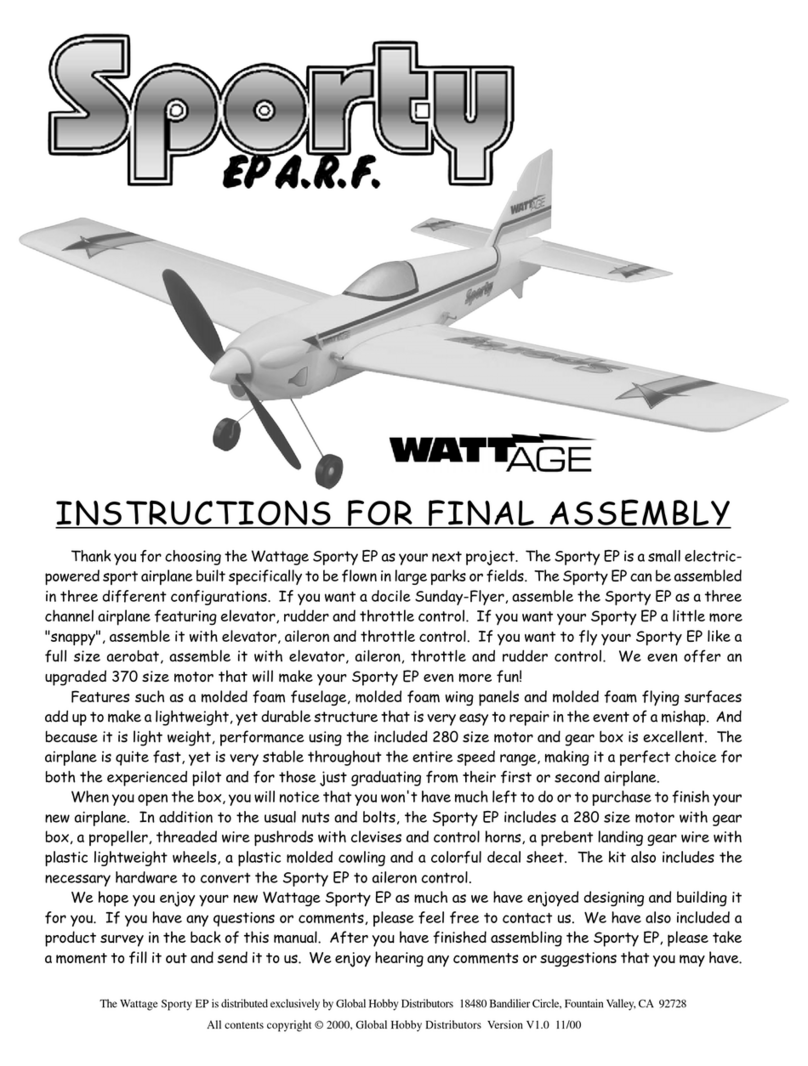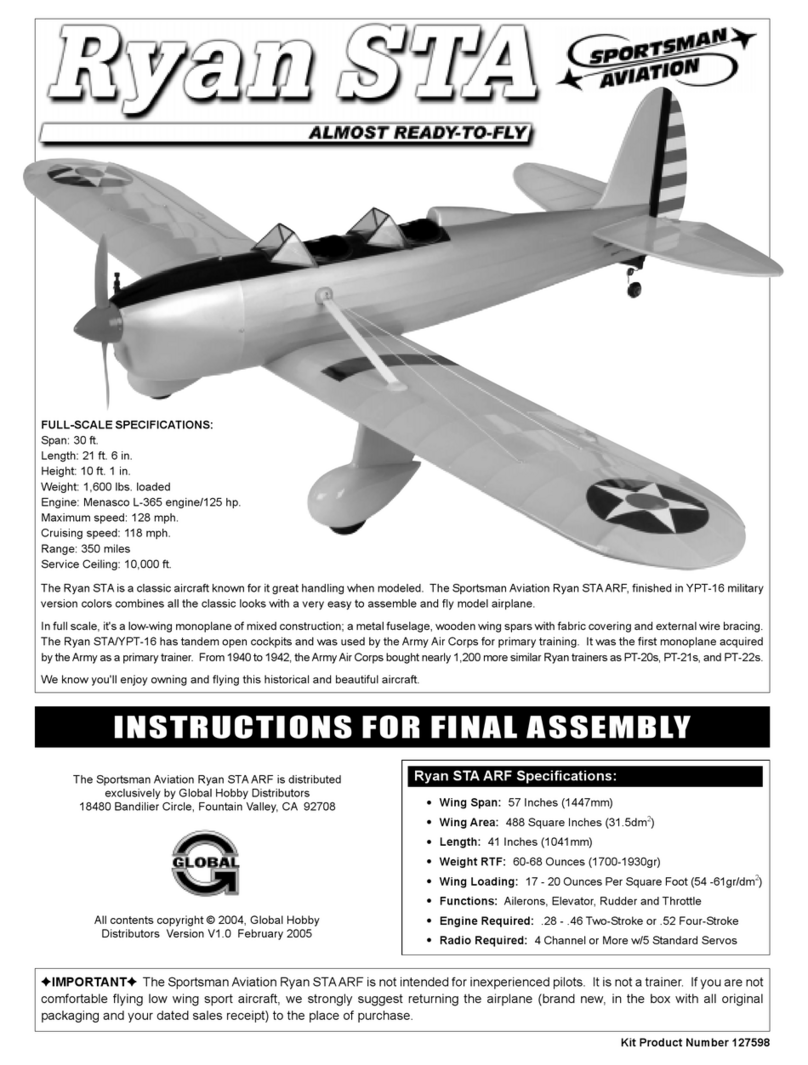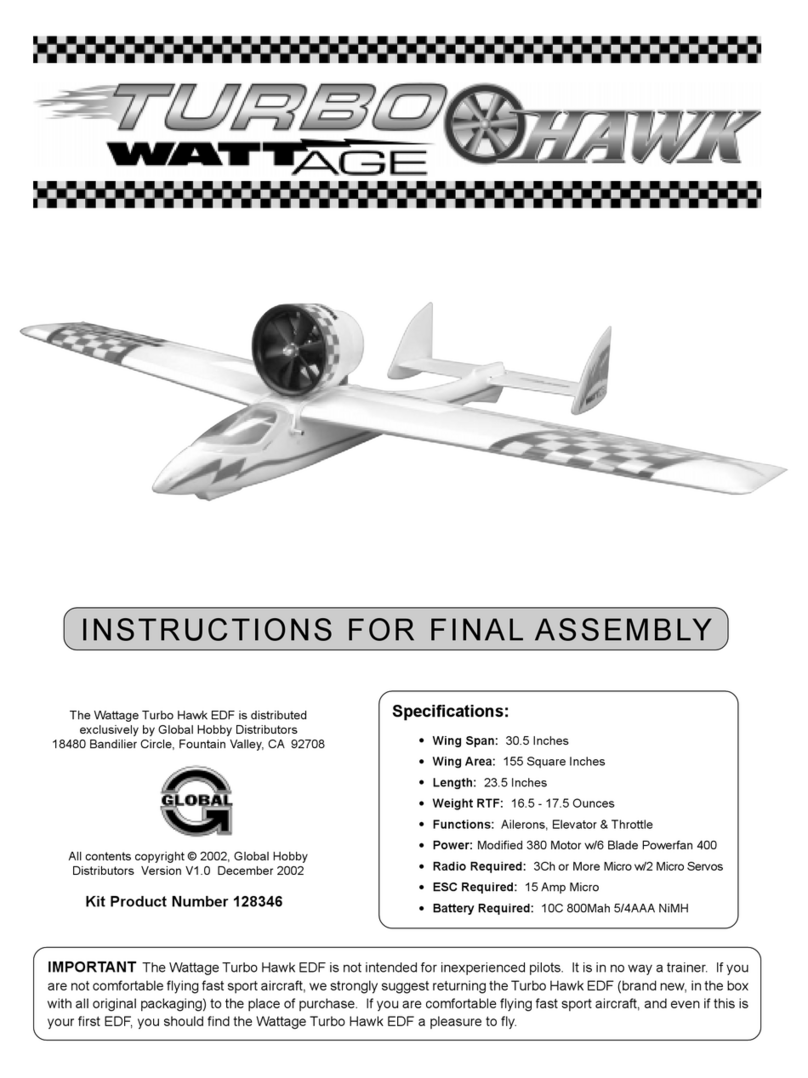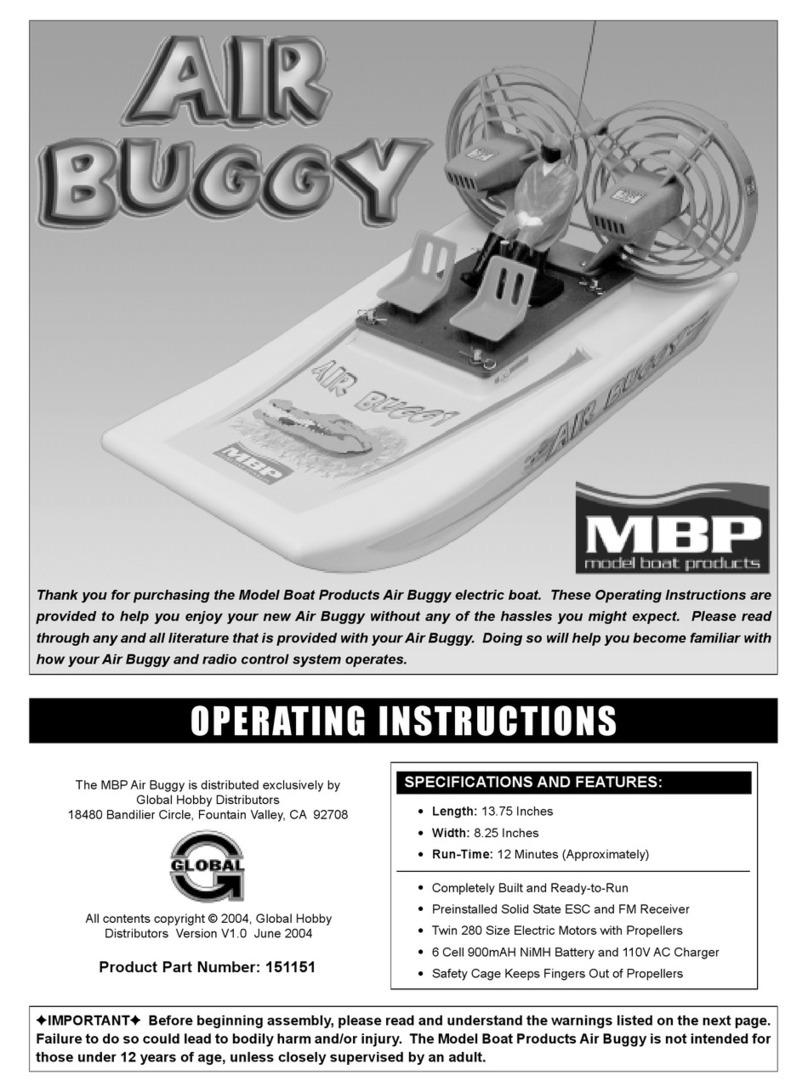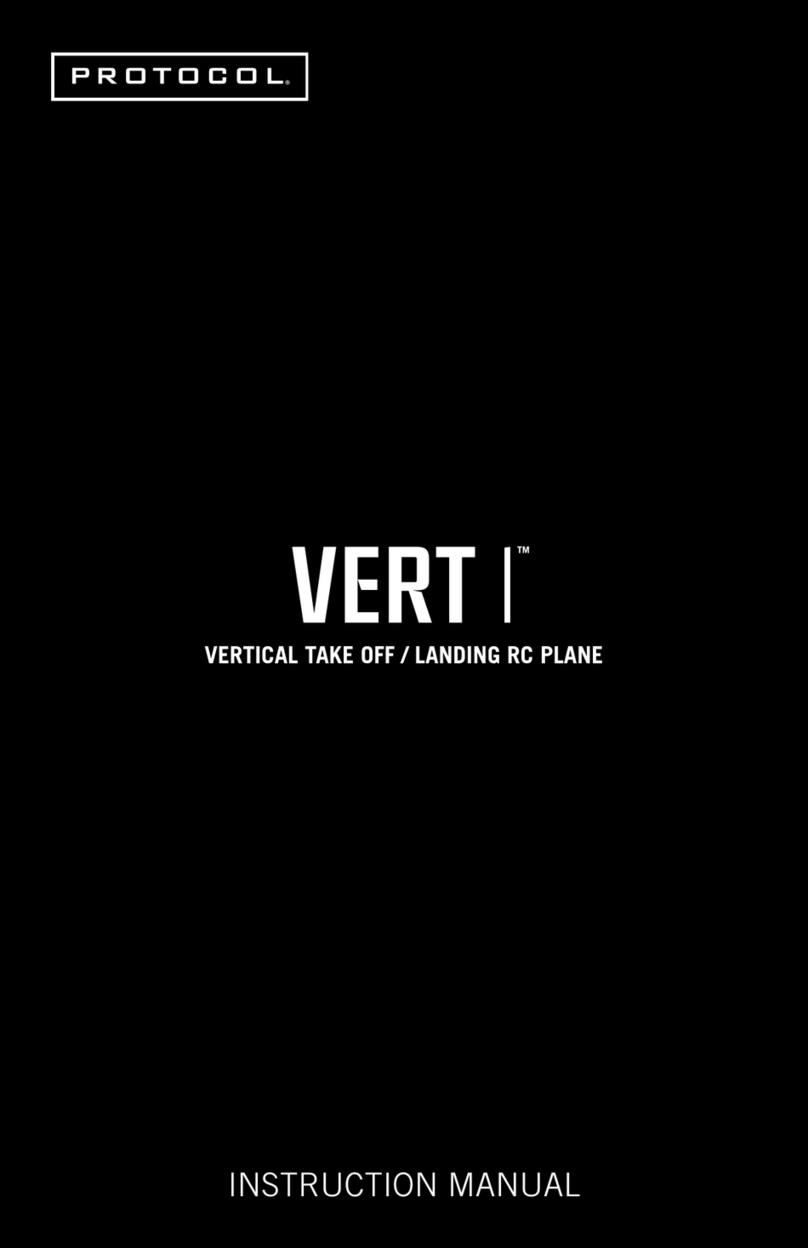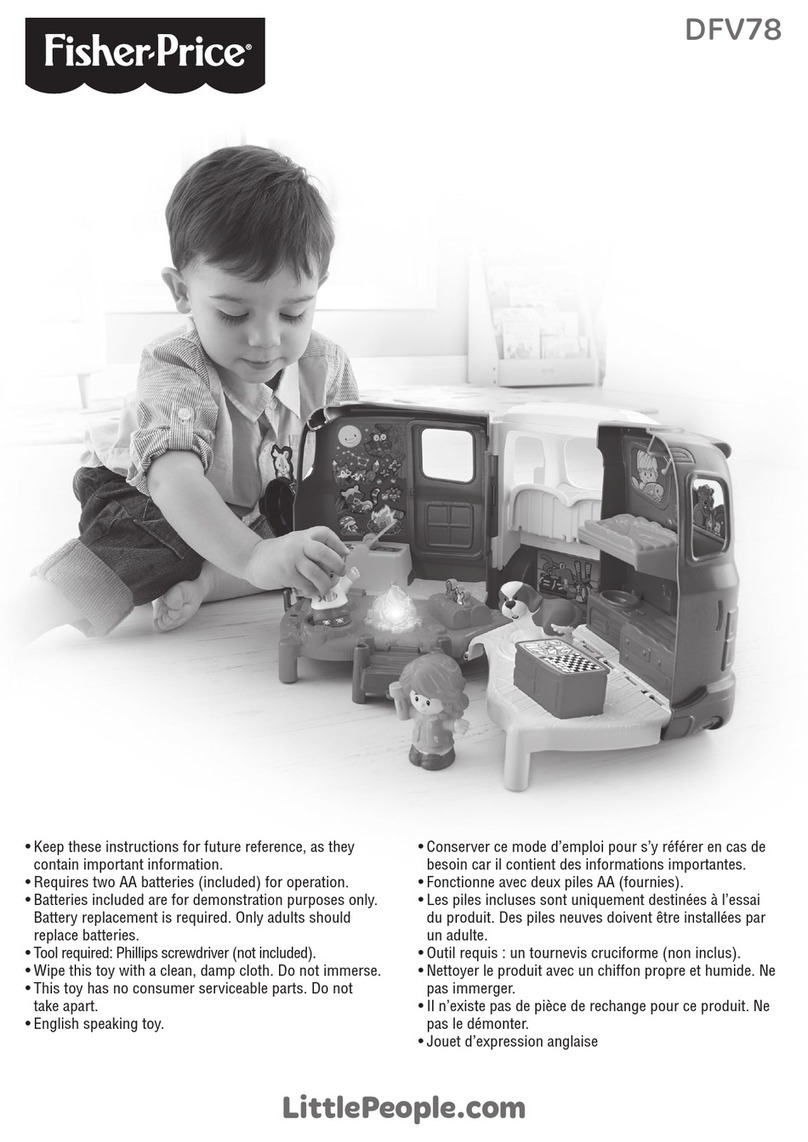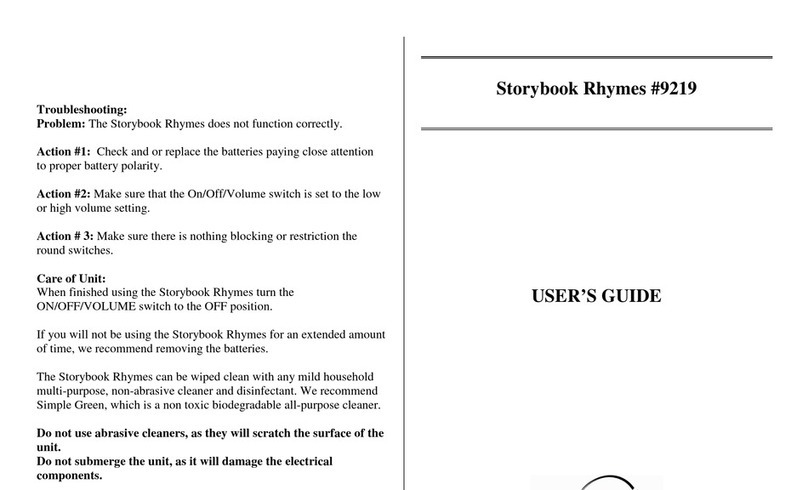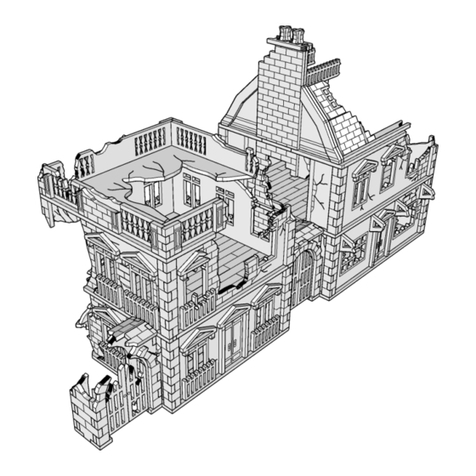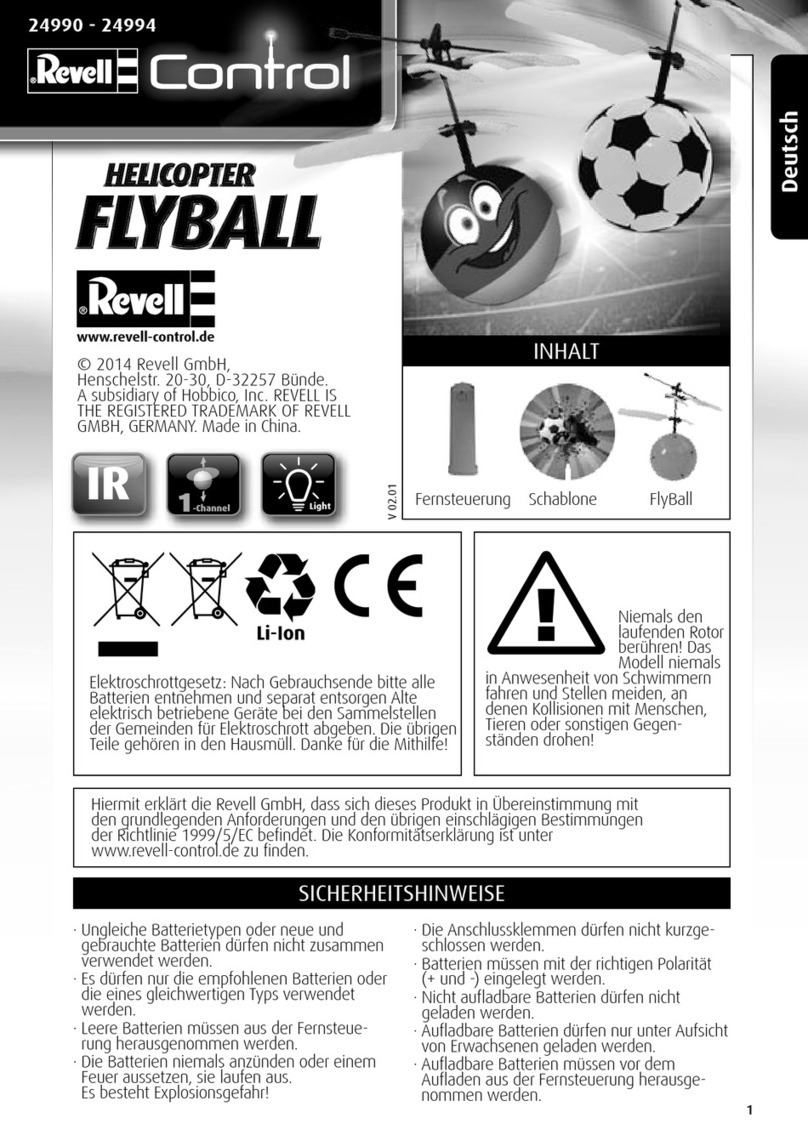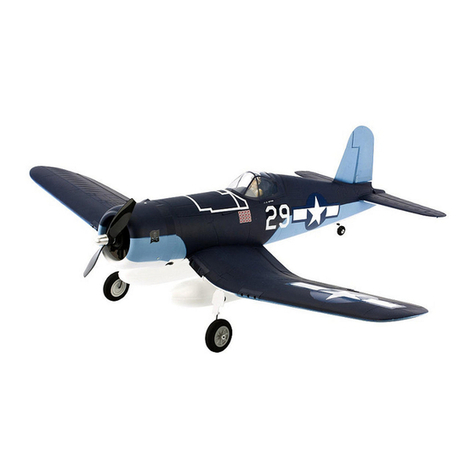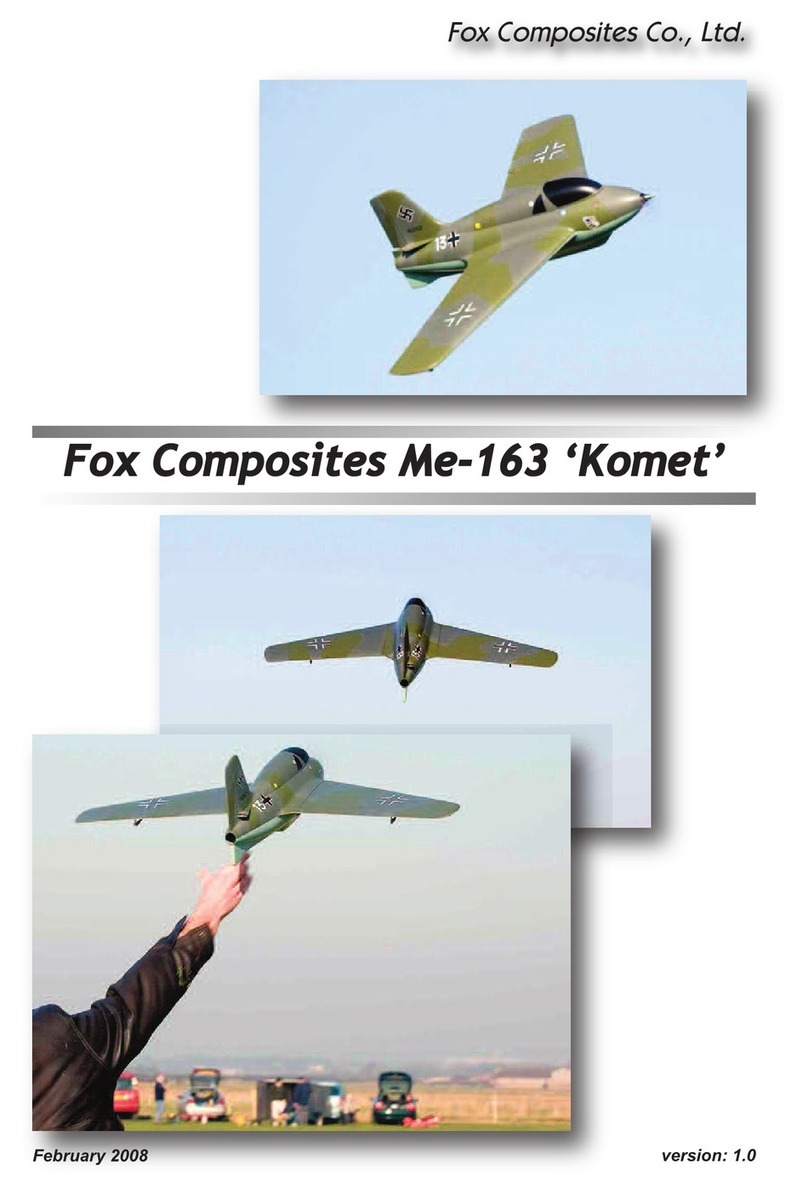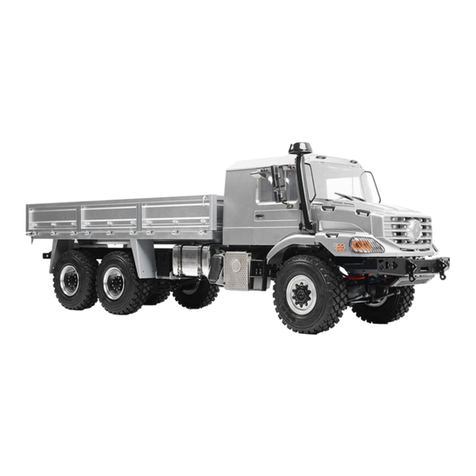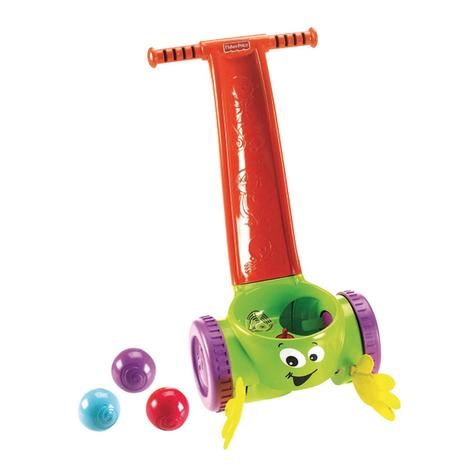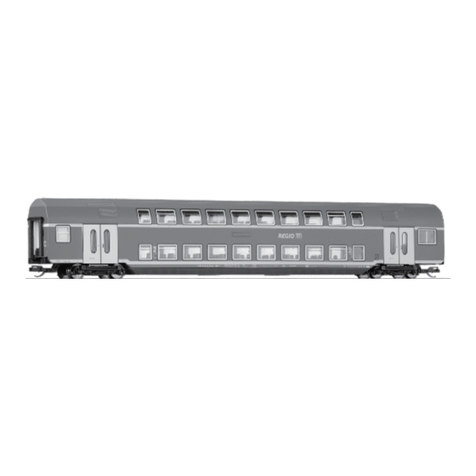Global Hobby Fokker D-VII User manual

1
INSTRUCTIONS FOR FINAL ASSEMBLY
The Fokker D-VII ARF is distributed exclusively by Global Hobby Distributors
18480 Bandilier Circle, Fountain Valley, CA 92728
All contents copyright © 2000, Global Hobby Distributors Version V1.0 9/00
To make your modeling experience totally enjoyable, we recommend that you get experienced, knowledgeable help
with assembly and during your first flights. Your local hobby shop has information about flying clubs in your area
whose membership includes qualified instructors. We also recommend that you contact the AMA at the address below.
They will be able to help you locate a flying field in your area.
Academy of Model Aeronautics
5151 East Memorial Drive
Muncie, IN 47302-9252
(800) 435-9262
www.modelaircraft.org
Global guarantees this kit to be free from defects in both material and workmanship at the date of purchase. This does
not cover any component parts damaged by use, misuse or modification. In no case shall Global's liability exceed
the original cost of the purchased kit.
In that Global has no control over the final assembly or material used for final assembly, no liability shall be assumed
for any damage resulting from the use by the user of the final user-assembled product. By the act of using the final
user-assembled product, the user accepts all resulting liability.

2
TABLE OF CONTENTS
SAFETY WARNING
This R/C airplane is not a toy! If misused, it can cause serious bodily injury and/or damage to property. Fly only
in open areas and preferably at a dedicated R/C flying site. We suggest having a qualified instructor carefully
inspect your airplane before its first flight. Please carefully read and follow all instructions included with this
airplane, your radio control system and your engine.
Safety Warning ............................................................... 2
Introduction ....................................................................3
Kit Contents....................................................................4
Additional Items Required ............................................. 5
Tools and Supplies Required ......................................... 5
Metric Conversion Chart................................................ 5
A Note About Covering ................................................. 6
Bottom Wing Assembly ................................................. 6
Installing the Dihedral Brace .................................. 6
Joining the Wing Halves......................................... 7
Top Wing Assembly.......................................................7
Installing the Dihedral Brace .................................. 7
Joining the Wing Halves......................................... 8
Bottom Wing Mounting .................................................9
Aligning the Wing................................................... 9
Installing the Blind Nuts ......................................... 9
Installing the Wing Bolt Doubler .........................10
Mounting the Wing ...............................................10
Horizontal Stabilizer .................................................... 10
Aligning the Stabilizer ..........................................10
Mounting the Stabilizer ........................................ 11
Vertical Stabilizer ......................................................... 12
Aligning the Stabilizer ..........................................12
Mounting the Stabilizer ........................................ 12
Installing the Triangle Stock.................................12
Top Wing Mounting ..................................................... 13
Installing the Cabane Struts .................................. 13
Installing the Outer N-Struts................................. 14
Aligning the Top Wing ......................................... 15
Mounting the Top Wing........................................ 15
Control Surface Hinging .............................................. 16
Hinging the Ailerons............................................. 16
Hinging the Elevator ............................................. 17
Hinging the Rudder............................................... 17
Tail Wheel Installation ................................................. 18
Tail Wheel Bracket Assembly ..............................18
Mounting the Tail Wheel Bracket ........................18
Installing the Tail Wheel....................................... 19
Main Gear Installation .................................................19
Installing the Gear Bracket ...................................19
Installing the Gear Wing ....................................... 20
Installing the Main Gear Wheels ..........................20
Engine Installation ....................................................... 21
Mounting the Engine to the Motor Mounts..........21
Aligning the Motor Mount Assembly .................. 21
Mounting the Engine to the Firewall....................22
Fuel Tank ...................................................................... 23
Stopper Assembly ................................................. 23
Installing the Stopper Assembly .................................. 23
Installing the Fuel Tank ........................................ 24
Servo Installation ......................................................... 24
Installing the Fuselage Servo Tray .......................24
Installing the Aileron Servo Tray ......................... 24
Installing the Servos ............................................. 25
Throttle Pushrod...........................................................25
Installing the Servo Connector .............................25
Adjusting the Throttle Linkage ............................ 26
Rudder Pushrod............................................................ 27
Installing the Control Horn................................... 27
Installing the Pushrod ........................................... 27
Adjusting the Rudder Pushrod..............................28
Elevator Pushrod ..........................................................29
Installing the Control Horn................................... 29
Installing the Pushrod ........................................... 29
Adjusting the Elevator Pushrod............................ 30
Aileron Pushrods.......................................................... 31
Installing the Pushrods.......................................... 31
Adjusting the Aileron Pushrods............................32
Windscreen ................................................................... 32
Trimming the Windscreen ....................................32
Mounting the Windscreen.....................................32
Machine Gun ................................................................ 33
Joining the Machine Gun Halves ......................... 33
Mounting the Machine Gun..................................33
Cowling ........................................................................34
Aligning the Cowl.................................................34
Mounting the Cowl ...............................................34
Final Assembly............................................................. 35
Installing the Switch ............................................. 35
Installing the Battery and Receiver ...................... 36
Balancing......................................................................36
Balancing the Fokker D-VII ................................. 36
Lateral Balancing ..................................................37
Control Throws ............................................................ 37
Preflight Check.............................................................37
Safety............................................................................ 37
Flying the Fokker D-VII .............................................. 38
Notes............................................................................. 38
Product Evaluation Sheet.............................................39

3
Thank you for choosing the Global Fokker D-VII ARF and welcome to the exciting world of WWI R/C
airplanes! We are sure that you will appreciate the high quality, easy assembly and excellent flight characteristics
of the Fokker D-VII ARF.
The full size Fokker D-VII was a single seat fighter that featured fabric-covered wings with plywood ribs
and plywood leading edges. The fuselage was wire-braced steel tubing, completely fabric-covered except for
the cowling, which was sheet steel. The two most successful engines used in the Fokker D-VII were the
Mercedes 160 H.P. and the BMW 185 H.P. engines. The Fokker D-VII, designed by Reinhold Platz, was a
clean, simple-looking biplane, equipped with two Maxim 08/15 7.92mm machine guns.
The Fokker D-VIIs were so successful that, in August of 1918 alone, they shot down 565 Allied aircraft.
One thing that made the Fokker D-VII such a formidable opponent was the fact that it could hang 45 degrees on
its prop and shoot without stalling. By doing this, the Fokker D-VII could fly up under the bellies of enemy
aircraft and shoot them down. The Fokker D-VII could climb 5000 meters in 16 minutes, fly at a ceiling of
19,685 feet, and had an insurance of 90 minutes. The aircraft had an approximate top speed of 124 mph.
Now you too can feel what that was like with your own Stand-Off Scale R/C model of the Fokker D-VII.
When you open up the box, you'll notice that you won't have much left to do or to purchase to finish your new
airplane. The Fokker D-VII is a complete kit. Wire Spoke wheels, fuel tank, pushrods, clevises and other
hardware are all included. The airframe is completely prebuilt and covered by master craftsmen, who take their
time to ensure that every part is straight and properly glued.
We hope you enjoy your new Fokker D-VII ARF as much as we have enjoyed designing and building it for
you. If you have any questions or comments, please feel free to contact us. We have also included a product
survey in the back of this manual. Please take the time to fill it out and send it to us. We would enjoy hearing
any comments or suggestions you may have.
This instruction manual is designed to guide you through the entire final assembly process of your new
Fokker D-VII ARF in the least amount of time possible. Along the way you'll learn how to properly
assemble your new airplane and also learn many tips that will help you in the future. We have listed some
of our recommendations below. Please read through them before going any further.
INTRODUCTION
✔Please read through each step before starting
assembly. You should find the layout very com-
plete and simple. Our goal is to guide you through
assembly without any of the headaches and hassles
you might expect.
✔There are check boxes next to each step. After
you complete a step, check off the box. This will
help you keep from losing your place.
✔Cover your work table with brown paper or a
soft cloth, both to protect the table and to protect
the individual parts.
✔Keep a couple of small bowls or jars handy to
put the small parts in after you open the accessory
bags.
✔We're all excited to get a new airplane in the
air, but take your time. This will ensure that you
build a straight, strong and great flying airplane.
✔If you come across this symbol , it means
that this is an important point or an assembly hint.
If you should find a part missing or damaged, or have any questions about assembly, please contact us at the
address below:
Global Hobby Distributors Customer Care
18480 Bandilier Circle
Fountain Valley, CA 92728
Phone: (714) 963-0329
Fax: (714) 964-6236
E-mail: service@globalhobby.net
☛

4
KIT CONTENTS
❑{1} Fuselage w/Pushrod Housings
❑{1} Top Wing - Right & Left Halves
❑{1} Bottom Wing - Right & Left Halves
❑{1} Horizontal Stabilizer w/Elevator & Hinges
❑{1} Vertical Stabilizer w/Rudder & Hinges
❑{1} Molded Fiberglass Cowl
❑{1} Molded Clear Windscreen
❑{1} Molded Plastic Machine Gun
❑{2} Wire Spoke Main Gear Wheels
❑{1} Precovered Landing Gear Wing
❑{1} Wire Landing Gear Strut
❑{2} Nylon Landing Gear Strap - Small Slot
❑{2} Nylon Landing Gear Strap - Large Slot
❑{8} 3mm x 12mm Wood Screws
❑{2} Nylon Wheel Spacers
❑{2} Wheel Collars w/3mm x 6mm Machine Screws
❑{2} Nylon Landing Gear Wing Mounts
❑{2} 3mm x 6mm Machine Screws
❑{4} 2mm x 5mm Wood Screws
❑{1} Prebent Tail Wheel Wire
❑{1} 25mm Diameter Wheel
❑{1} Nylon Mounting Bracket
❑{1} Nylon Steering Arm
❑{2} 1.5mm Wheel Collars
❑{2} 3mm x 6mm Machine Screws
❑{3} 3mm x 12mm Wood Screws
❑{1} 2mm x 10mm Wood Screw
❑{1} Nylon Pushrod Tube
❑{1} 2mm x 90mm Threaded Wire w/L-Bend
❑{1} 2mm x 100mm Threaded Wire
❑{1} Nylon Clevis
❑{1} Nylon Snap Keeper
❑{1} Nylon Control Horn w/Backplate
❑{2} 2mm x 15mm Machine Screws
❑{1} Nylon Pushrod Tube
❑{1} 2mm x 90mm Threaded Wire w/L-Bend
❑{1} 2mm x 100mm Threaded Wire
❑{1} Nylon Clevis
❑{1} Nylon Snap Keeper
❑{1} Nylon Control Horn w/Backplate
❑{2} 2mm x 15mm Machine Screws
❑{2} 2mm x 50mm Threaded Wires w/L-Bends
❑{2} Nylon Clevises
❑{2} Nylon Snap Keepers
❑{1} 1.5mm x 350mm Wire w/Z-Bend
❑{1} Adjustable Servo Connector Assembly
❑{4} Aluminum Cabane Struts (2 left & 2 right)
❑{4} Aluminum Wing Mounts (2 left & 2 right)
❑{2} Upper Strut Stabilizer Rods (1 left & 1 right)
❑{2} Lower Strut Stabilizer Rods (1 left & 1 right)
❑{2} Aluminum Strut Stabilizer Rod Clamps
❑{2} Precovered Outer N-Struts
❑{8} 3mm x 12mm Wood Screws
❑{4} 3mm x 15mm Machine Screws
❑{4} 3mm Nylon Insert Nuts
❑{4} 3mm x 10mm Wood Screws
❑{8} 3mm Blind Nuts
❑{4} 3mm Split Washers
❑{12}3mm x 10mm Machine Screws
❑{12}3mm Flat Washers
❑{2} Nylon Motor Mount Beams
❑{4} 3mm x 20mm Machine Screws
❑{4} 3mm x 25mm Machine Screws
❑{4} 3mm Nylon Insert Nuts
❑{4} 3mm Blind Nuts
❑{12}3mm Flat Washers
❑{1} Molded Fuel Tank
❑{1} Rubber Stopper
❑{1} 20mm Diameter Front Plate
❑{1} 17mm Diameter Back Plate
❑{1} 3mm x 18mm Machine Screw
❑{1} Weighted Fuel Pick-Up
❑{3} Aluminum Tubes
❑{1} Silicon Fuel Tubing
❑{1} Top Wing Dihedral Brace (W-25)
❑{1} Bottom Wing Dihedral Brace (W-26)
❑{2} Precovered Triangle Stock (RT-8)
❑{1} Precovered Square Stock
❑{1} Wing Bolt Doubler (W-30)
❑{1} Aileron Servo Tray (W-9C)
❑{1} Rear Aileron Servo Tray Block (W-9B)
❑{1} Front Aileron Servo Tray Block (W-9A)
❑{1} Fuselage Servo Tray (D-38)
❑{6} 3mm x 6mm Wood Screws
❑{2} 4mm x 25mm Machine Screws
❑{2} 4mm Flat Washers
❑{2} 4mm Blind Nuts
❑{1} 40mm Clear Tubing
AIRFRAME ASSEMBLIES
MAIN LANDING GEAR ASSEMBLY
TAIL WHEEL ASSEMBLY
ELEVATOR CONTROL SYSTEM
RUDDER CONTROL SYSTEM
AILERON CONTROL SYSTEM
THROTTLE CONTROL SYSTEM
WING STRUT ASSEMBLIES
MOTOR MOUNT ASSEMBLY
FUEL TANK ASSEMBLY
MISCELLANEOUS ITEMS

5
ADDITIONAL ITEMS REQUIRED
❑{1} Hitec Focus 4FM Radio w/4 Servos
❑{1} Dubro 1/4" Foam Rubber # 868638
❑{1} Global XX-Silicon Fuel Line # 115923
❑{1} Magnum Fueling Valve # 237500
OPTIONAL ITEMS
❑{1} Williams Bros. 2-5/8" Pilot # 592659
❑{1} Ernst External Charge Jack # 223730
❑{1} Cirrus On-Board Battery Indicator # 444762
❑{1} Formula-U Flat Black Paint # 586859
❑{1} Goldberg 1/4" Black Trim Tape # 582023
IF YOU USE A TWO CYCLE ENGINE...
❑{1} Magnum XL .46ARNV Engine # 210746
❑{1} APC 11 x 6 Propeller # 608560
❑{1} Thunderbolt R/C Long Glow Plug # 115493
IF YOU USE A FOUR CYCLE ENGINE...
❑{1} Magnum XL .52RFS Engine # 210980
❑{1} APC 12 x 6 Propeller # 608660
❑{1} Thunderbolt 4-Cycle Glow Plug # 115490
The optional Ernst Charge Jack and Cirrus On-Board
Battery Indicator are for use with Hitec and JR Radio
systems. These items are also available for use with
Futaba and Airtronics radio systems. Please check with
your retailer for availability.
TOOLS AND SUPPLIES REQUIRED
❑Kwik Bond Thin C/A # 887500
❑Kwik Bond Thick C/A # 887510
❑Kwik Bond 5 Minute Epoxy # 887560
❑Kwik Bond 30 Minute Epoxy # 887565
❑Formula-560 Canopy Glue # 339176
❑Pacer Blue Thread Lock # 339162
❑Wilhold Silicon Sealant # 335407
❑Robart Incidence Meter # 561554
❑Excel Modeling Knife # 692808
❑Magnum Tubing Bender # 237474
❑Ernst Airplane Stand # 223977
❑Masking Tape # 229685
❑Electric Drill
❑Assorted Drill Bits
❑Dremel Tool w/Assorted Bits
❑Straight Edge Ruler
❑Phillips Head Screwdriver
❑Wire Cutters
❑Needle Nose Pliers
❑Scissors
❑Pen or Pencil
❑Builder's Triangle
❑220 Grit Sandpaper w/Sanding Block
❑Paper Towels
❑Rubbing Alcohol
❑Waxed Paper
❑Machine Oil or Vaseline
❑NHP Epoxy Mixing Sticks # 864204
❑NHP Mixing Cups # 864205
METRIC CONVERSION CHART
To convert inches into millimeters: Inches x 25.4 = mm
1/64" = .4mm
1/32" = .8mm
1/16" = 1.6mm
3/32" = 2.4mm
1/8" = 3.2mm
5/32" = 4.0mm
3/16" = 4.8mm
1/4" = 6.4mm
3/8" = 9.5mm
1/2" = 12.7mm
5/8" = 15.9mm
3/4" = 19.0mm
1" = 25.4mm
2" = 50.8mm
3" = 76.2mm
6" = 152.4mm
12" = 304.8mm
18" = 457.2mm
21" = 533.4mm
24" = 609.6mm
30" = 762.0mm
36" = 914.4mm
For a more scale appearance we recommend that you paint the aluminum wing strut mount system flat black. If you
decide to do this you should first roughen each part using fine grade sandpaper (400 grit works well) then wash the parts
in soap and warm water to remove any oil residue. Paint the individual parts before mounting them to the airplane.

6
The covering material used on the Fokker D-VII is a heat shrink polyester material. Because of this, it is
possible with heat and humidity changes that the covering on your airplane may wrinkle or sag. This trait is
inherent in all types of heat shrink material. To remove the wrinkles you will need to purchase, or borrow from a
fellow modeler, a heat iron. If you need to purchase one, the Global Sealing Iron # 360900 is recommended.
Follow these simple steps to remove the wrinkles:
❑1) Plug in and turn on the sealing iron to the medium temperature setting. Allow the iron to heat up for
approximately 5 - 7 minutes.
❑2) After the iron has reached temperature, lightly apply the iron to the wrinkled section of the cover-
ing. Move the iron slowly over the wrinkled section until the covering tightens and the wrinkles disappear.
You will notice that the color of the covering will darken when it is heated. When the covering cools back
down, it will return to its normal color.
☛If the color layer smears from any of the seams, the temperature of the iron is too hot. Turn the tempera-
ture dial down and wait about 5 minutes for the iron to adjust to the lower temperature. You can remove any
excess color streaks using a paper towel soaked with a small quantity of acetone.
A NOTE ABOUT COVERING
PARTS REQUIRED
❑{1} Bottom Wing - Right & Left Halves
❑{1} Bottom Wing Dihedral Brace (W-26)
TOOLS AND SUPPLIES REQUIRED
❑Kwik Bond 30 Minute Epoxy
❑Excel Modeling Knife
❑Masking Tape
❑Straight Edge Ruler
❑Pen or Pencil
❑220 Grit Sandpaper w/Sanding Block
❑Paper Towels
❑Rubbing Alcohol
❑NHP Epoxy Mixing Sticks
❑NHP Epoxy Mixing Cups
BOTTOM WING ASSEMBLY
INSTALLING THE DIHEDRAL BRACE
❑1) Look carefully at the surface of each root rib
on both wing halves. Notice how the excess cover-
ing material overlaps onto them. Using a modeling
knife, carefully trim and remove the excess from both
of the root ribs, leaving about 1/16" of covering ma-
terial overlapping so it does not pull away later.
☛Removing most of the covering from the two
root ribs will expose more of the wood. This will
result in a stronger joint when the wing halves are
epoxied together later.
❑2) Using a straight edge ruler and a pen, locate
andmark the centerlineof the plywooddihedral brace
(W-26). Draw one vertical line, on each side of the
brace, at this location. See photo # 1 below.
Photo # 1
❑3) Test fit the plywood dihedral brace into the
plywood dihedral brace box in each wing half. The
brace should slide into each wing half up to its cen-
terline. If it does not, remove the brace and lightly
sand the edges and tips until the proper fit is obtained.
See photo # 2 below.
Photo # 2

7
☛The dihedral brace is cut in the shape of a "V".
The "V" shape should face the topsurface of the wing
when the brace is installed.
❑4) Test fit both of the wing halves together with
the dihedral brace temporarily installed (without us-
ing glue). Look carefully at the center section joint:
the wing halves should fit together tightly with few
or no gaps in the joint. See photo # 3 below.
Photo # 3
❑5) If the center section joint is not tight, remove
the wing halves and the dihedral brace, and lightly
sand the edges and tips of the brace. Test fit the wing
halves together with the dihedral brace installed again
and repeat until you are satisfied with the fit. Once
you are satisfied with the fit, remove the wing halves
and the dihedral brace.
☛It is important that the wing halves fit together
properly. The better the fit, the stronger the center
section joint will be.
❑6) Following the instructions on the packaging,
mix a generous amount of Kwik Bond 30 Minute
Epoxy. Mix the epoxy for about 1 minute. This will
ensure that both parts are thoroughly incorporated.
❑7) Working with only one wing half for now,
apply a thin layer of epoxy inside the plywood dihe-
dral brace box and to only half of the dihedral brace.
Make sure to cover the top and bottom, as well as the
sides, and use enough epoxy to fill any gaps.
❑8) Slide the dihedral brace into the wing half
up to its centerline. Remove any excess epoxy be-
fore it dries, using a paper towel and rubbing alcohol.
Allow the epoxy to fully cure before proceeding.
❑9) Once the epoxy has fully cured, trial fit both
wing halves together again to double check that the
wing halves still fit together properly.
JOINING THE WING HALVES
❑10) Mix a generous amount of Kwik Bond 30
Minute Epoxy. Apply a thin layer of epoxy to the
exposed half of the dihedral brace, the inside of the
second wing half, and the entiresurface ofbothroot
ribs. Make sure to use enough epoxy to fill any gaps.
❑11) Slide the two wing halves together and care-
fully align them at both the leading and trailing edges.
Wipe away any excess epoxy, using a paper towel
and rubbing alcohol, and use several pieces of mask-
ing tape to hold the two wing halves aligned until the
epoxy fully cures.
❑12) Once the epoxy has fully cured, double-
check the center section joint. If any gaps are present,
mix a small amount of Kwik Bond 30 Minute Epoxy
and carefully fill any remaining gaps. Remove any
excess epoxy using a paper towel and rubbing alco-
hol, and allow the epoxy to thoroughly cure.
❑13) Once the epoxy has fully cured, carefully
remove the masking tape from the wing.
PARTS REQUIRED
❑{1} Top Wing - Right & Left Halves
❑{1} Top Wing Dihedral Brace (W-25)
TOOLS AND SUPPLIES REQUIRED
❑Kwik Bond 30 Minute Epoxy
❑Excel Modeling Knife
❑Masking Tape
❑Straight Edge Ruler
❑Pen or Pencil
❑220 Grit Sandpaper w/Sanding Block
❑Paper Towels
❑Rubbing Alcohol
❑NHP Epoxy Mixing Sticks
❑NHP Epoxy Mixing Cups
TOP WING ASSEMBLY
INSTALLING THE DIHEDRAL BRACE
❑1) Look carefully at the surface of each root rib
on both wing halves. Notice how the excess cover-
ing material overlaps onto them. Using a modeling
knife, carefully trim and remove the excess from both
of the root ribs, leaving about 1/16" of covering ma-
terial overlapping so it does not pull away later.
☛Removing most of the covering from the two
root ribs will expose more of the wood. This will
result in a stronger joint when the wing halves are
epoxied together later.

8
❑2) Using a straight edge ruler and a pen, locate
andmark the centerlineof the plywooddihedral brace
(W-25). Draw one vertical line, on each side of the
brace, at this location.
❑3) Test fit the plywood dihedral brace into the
plywood dihedral brace box in each wing half. The
brace should slide into each wing half up to its cen-
terline. If it does not, remove the brace and lightly
sand the edges and tips until the proper fit is obtained.
See photo # 4 below.
Photo # 4
☛The dihedral brace is cut straight, so it doesn't
matter which direction it is installed into the wing.
❑4) Test fit both of the wing halves together with
the dihedral brace temporarily installed (without us-
ing glue). Look carefully at the center section joint:
the wing halves should fit together tightly with few
or no gaps in the joint. See photo # 5 below.
Photo # 5
❑5) If the center section joint is not tight, remove
the wing halves and the dihedral brace, and lightly
sand the edges and tips of the brace. Test fit the wing
halves together with the dihedral brace installed again
and repeat until you are satisfied with the fit. Once
you are satisfied with the fit, remove the wing halves
and the dihedral brace.
☛It is important that the wing halves fit together
properly. The better the fit, the stronger the center
section joint will be.
❑6) Following the instructions on the packaging,
mix a generous amount of Kwik Bond 30 Minute
Epoxy. Mix the epoxy for about 1 minute. This will
ensure that both parts are thoroughly incorporated.
❑7) Working with only one wing half for now,
apply a thin layer of epoxy inside the plywood dihe-
dral brace box and to only half of the dihedral brace.
Make sure to cover the top and bottom, as well as the
sides, and use enough epoxy to fill any gaps.
❑8) Slide the dihedral brace into the wing half
up to its centerline. Remove any excess epoxy be-
fore it dries, using a paper towel and rubbing alcohol.
Allow the epoxy to fully cure before proceeding.
❑9) Once the epoxy has fully cured, trial fit both
wing halves together again to double check that the
wing halves still fit together properly.
❑10) Mix a generous amount of Kwik Bond 30
Minute Epoxy. Apply a thin layer of epoxy to the
exposed half of the dihedral brace, the inside of the
second wing half, and the entire surfaceof bothroot
ribs. Make sure to use enough epoxy to fill any gaps.
❑11) Slide the two wing halves together and care-
fully align them at both the leading and trailing edges.
Wipe away any excess epoxy using a paper towel
and rubbing alcohol and use several pieces of mask-
ing tape to hold the two wing halves aligned until the
epoxy fully cures.
❑12) Once the epoxy has fully cured, double-
check the center section joint. If any gaps are present,
mix a small amount of Kwik Bond 30 Minute Epoxy
and carefully fill any remaining gaps. Remove any
excess epoxy, using a paper towel and rubbing alco-
hol, and allow the epoxy to thoroughly cure.
❑13) After the epoxy has fully cured, carefully
remove the masking tape from the wing. If any resi-
due is left from the tape, it can be removed using a
paper towel soaked with a small amount of rubbing
alcohol.
JOINING THE WING HALVES

9
PARTS REQUIRED
❑{1} Wing Bolt Doubler (W-30)
❑{2} 4mm x 25mm Machine Screws
❑{2} 4mm Flat Washers
❑{2} 4mm Blind Nuts
TOOLS AND SUPPLIES REQUIRED
❑Kwik Bond Thick C/A
❑Excel Modeling Knife
❑Ernst Airplane Stand
❑Masking Tape
❑Electric Drill
❑5/32" & 7/32" Drill Bits
❑Straight Edge Ruler
❑Phillips Head Screwdriver
❑Needle Nose Pliers
❑Pen or Pencil
BOTTOM WING MOUNTING
ALIGNING THE WING
❑1) Set the fuselage upside down in your airplane
stand and place the bottom wing into the wing saddle.
Align the two hardwood dowels in the leading edge
of the wing with the two predrilled holes in the
fuselage's forward bulkhead.
❑2) Carefully slide the wing forward, making
sure that the two hardwood dowels fully engage the
two predrilled holes in the forward bulkhead.
❑3) Using a ruler and a pen, locate the center-
line of the fuselage, at the back edge of the wing
saddle, and place a mark. See photo # 6 below.
Photo # 6
❑4) The joint where the two wing halves were
glued together is the centerline of the wing. Align
thecenterline ofthe wingwith thecenterline youdrew
on the bottom of the fuselage.
❑5) While holding the wing in alignment, use a
couple of pieces of masking tape to hold the wing
securely to the fuselage.
❑6) Remove the two ailerons from the wing and
set them aside for now.
❑7) Check that the wing is square to the fuse-
lage. To do this use a ruler and carefully measure
from the trailing edge of each wing tip to the back
edge of the fuselage. Both of these measurements
should be the same. See figure # 1 below.
❑8) If the two measurements are not the same,
carefully lift the masking tape and adjust the back of
the wing until they are. When you are satisfied with
the alignment, reattach the masking tape to hold the
wing securely in place.
Figure # 1
INSTALLING THE BLIND NUTS
❑9) Using a ruler and a pen, measure 3/8" in front
of the trailing edge of the wing and place two marks,
one on each side of the centerline. Now measure
1-9/32" out from each side of the centerline and place
two marks. See photo # 7 below.
Photo # 7
❑10) Using a drill with a 5/32" drill bit, carefully
drill two holes into the wing and down through the
plywood wing hold down block inside the fuselage.
☛Angle the drill bit so that the holes will be per-
pendicular to the bottom of the wing.
❑11) Remove the wing from the wing saddle.
Using a drill with a 7/32" drill bit, enlarge only the
two holes in the plywood mounting block.
A = A-1

10
❑12) Install the two 4mm blind nuts into the bot-
tom of the plywood mounting plate. Use a pair of
needle nose pliers to squeeze the blind nuts up into
place. See photo # 8 below.
Photo # 8
☛A balsa filler block has been preinstalled onto
the bottom of the plywood plate to make it easier to
install the blind nuts.
❑13) With the blind nuts fully seated, carefully
apply a bead of Kwik Bond Thick C/A around the
bottom of each blind nut to lock them into place. Be
careful not to get any glue into the threads and allow
the C/A to fully cure before proceeding.
INSTALLING THE WING BOLT DOUBLER
❑14) Place the wing back into the wing saddle
and realign it. Use a couple of pieces of masking
tape to hold it in place.
❑15) Set the wing bolt doubler (W-30) in place
on the bottom of the wing. The back edge of the
doubler should be about 1/16" in front of the trailing
edge and the sides of the doubler should be even with
the sides of the fuselage. See photo # 9 below.
❑16) While holding the wing bolt doubler in
place,use a penand outlinethe doubler onto the wing.
❑17) Remove the doubler from the wing. Using
a modeling knife, carefully remove the covering from
inside the outline you drew.
Photo # 9
❑18) Apply a generous amount of Kwik Bond
Thick C/A to the bottom of the doubler. Set the dou-
bler back into place and realign it. Hold the doubler
firmly in place until the C/A fully cures.
❑19) Remove the wing from the wing saddle.
Using a drill with a 5/32" drill bit, drill the two wing
mounting screw holes through the wing bolt doubler.
Use the holes you drilled through the wing as a guide.
MOUNTING THE WING
❑20) Place the wing back into the wing saddle
and bolt it in place using the two 4mm x 25mm ma-
chine screws and two 4mm flat washers. Tighten the
screws firmly using a phillips head screwdriver. See
photo # 10 below.
Photo # 10
PARTS REQUIRED
❑{1} Horizontal Stabilizer w/Elevator & Hinges
TOOLS AND SUPPLIES REQUIRED
❑Kwik Bond 30 Minute Epoxy
❑Excel Modeling Knife
❑Ernst Airplane Stand
❑Masking Tape
❑Straight Edge Ruler
❑Pen or Pencil
❑Builder's Triangle
❑220 Grit Sandpaper w/Sanding Block
❑Paper Towels
❑Rubbing Alcohol
❑NHP Epoxy Mixing Sticks
❑NHP Epoxy Mixing Cups
HORIZONTAL STABILIZER
ALIGNING THE STABILIZER
❑1) Remove the elevator and hinges from the
horizontal stabilizer and set them aside for now.

11
Photo # 11
❑4) Mount the bottom wing to the fuselage. With
the fuselage securely in your airplane stand, set the
stabilizeronto thestabilizer mountingsides. The trail-
ing edge of the stabilizer should be even with the
back edge of the fuselage.
❑5) Align the centerline mark on the trailing edge
of the stabilizer with the center of the back edge of
the fuselage. When that is aligned, hold the trailing
edge of the stabilizer in that position using a piece of
masking tape.
❑6) With the stabilizer in place, look carefully
from the front of the fuselage at both the wing and
the stabilizer. When aligned properly, the stabilizer
should be level with the wing. If it is not level, use
220 grit sandpaper and a sanding block to sand down
the higher stabilizer mounting side until the correct
alignment is achieved. See figure # 2 below.
❑2) Using a ruler and a pen, locate and mark the
centerline of the horizontal stabilizer, at the trailing
edge, and place a mark. Using a builder's triangle,
extend this mark from front to back across the top
and bottom of the stabilizer.
❑3) Using a modeling knife, carefullyremove the
coveringfrom thetops ofthe stabilizermounting sides
on the fuselage. See photo # 11 below.
Figure # 2
❑7) Now check to make sure that the tips of the
stabilizerare equaldistances from the tips of the wing.
Use a ruler and measure from one wing tip to the
Figure # 3
❑8) When you are satisfied with the alignment,
hold the stabilizer firmly in place using a couple of
pieces of masking tape. Do not use glue yet!
MOUNTING THE STABILIZER
❑9) With the stabilizer held firmly in place, use a
pen to draw lines onto the bottom of the stabilizer
where it and the fuselage sides meet. Do this on both
the right and left sides.
❑10) Remove the stabilizer from the fuselage.
Using the lines you just drew as a guide, carefully
remove the covering from between them using a
modeling knife. See photo # 12 below.
Photo # 12
☛When cutting through the covering to remove
it, cut with only enough pressure to cut through only
the covering itself. Cutting into the balsa will weaken
the stabilizer.
❑11) Mix a generous amount of Kwik Bond 30
Minute Epoxy. Apply a thin layer to the mounting
area on the bottom of the stabilizer and to the tops of
the stabilizer mounting sides and cross-member on
the fuselage.
B = B-1
stabilizer tip on the same side. Do this for both
sides. When the stabilizer is aligned properly, both
of these measurements should be the same. See
figure # 3 below.
C = C-1

12
❑12) Set the stabilizer back into place and realign
it, double checking all of your measurements once
more. When satisfied with the alignment, hold the
stabilizer in place using several pieces of masking
tape and remove any excessepoxy usinga papertowel
and rubbing alcohol before it cures. Allow the epoxy
to fully cure before proceeding.
PARTS REQUIRED
❑{1} Vertical Stabilizer w/Rudder & Hinges
❑{2} Precovered Triangle Stock (RT-8)
TOOLS AND SUPPLIES REQUIRED
❑Kwik Bond Thick C/A
❑Kwik Bond 30 Minute Epoxy
❑Excel Modeling Knife
❑Ernst Airplane Stand
❑Masking Tape
❑Pen or Pencil
❑Builder's Triangle
❑Paper Towels
❑Rubbing Alcohol
❑NHP Epoxy Mixing Sticks
❑NHP Epoxy Mixing Cups
VERTICAL STABILIZER
ALIGNING THE STABILIZER
❑1) Remove the rudder and the hinges from the
stabilizer and set them aside for now.
❑2) Using a modeling knife, remove the cover-
ing from over the top of the precut slot in the
horizontal stabilizer.
❑3) Set the vertical stabilizer in place, making
sure that the tab in the bottom of the stabilizer is
pushed down firmly into the precut slot. The front
of the stabilizer should also be lined up with the
centerline you drew previously on the horizontal
stabilizer.
Photo # 13
☛When cutting through the covering to remove
it, cut with only enough pressure to cut through only
the covering itself. Cutting into the balsa will weaken
the structure.
❑6) Set the vertical stabilizer back into place and
realign it. Using a builder's triangle, check to ensure
that the vertical stabilizer is aligned 90º to the hori-
zontal stabilizer. See figure # 4 below.
Figure # 4
MOUNTING THE STABILIZER
❑4) While holding the vertical stabilizer firmly
in place, use a pen to draw a line on each side of it
where it meets the top of the horizontal stabilizer.
Also draw a line on top of the horizontal stabilizer
around the base of the vertical stabilizer.
❑5) Remove the stabilizer. Using a modeling
knife, carefully remove the covering from below the
lines you drew and from the bottom edge of the sta-
bilizer. Also remove the covering from inside the
outline you drew on top of the horizontal stabilizer.
See photo # 13 below.
❑7) Mix a generous amount of Kwik Bond 30
Minute Epoxy. Apply a thin layer to the mounting
slot in the horizontal stabilizer and to the sides and
bottom of the vertical stabilizer mounting area. Also
apply epoxy to the top of the horizontal stabilizer.
❑8) Set the stabilizer back into place and realign
it, double checking all of your measurements. Hold
the stabilizer in place using several pieces of mask-
ing tape and remove any excess epoxy using a paper
towel and rubbing alcohol. Allow the epoxy to fully
cure before proceeding.
INSTALLING THE TRIANGLE STOCK
❑9) Using a modeling knife, remove the cover-
ingthat overlapsonto theinner edgesof the twopieces
of precovered triangle stock.

13
❑10) Working with one piece of triangle stock for
now, align it in the joint between the horizontal and
vertical stabilizers. When it's properly aligned, the
triangle stock should be even with the trailing edges
of the stabilizers. See photo # 14 below.
Photo # 14
❑11) When satisfied with the alignment, hold the
triangle stock in place and trace around it using a
pen.
❑12) Remove the triangle stock. Using a model-
ing knife, carefully remove the covering from inside
the outline you drew.
❑13) Glue the triangle stock into place using
Kwik Bond Thick C/A. Allow the C/A to cure com-
pletely before proceeding.
☛The triangle stock adds a lot of strength to the
joint between the stabilizers. It is important that it be
glued in securely.
❑14) Repeat steps # 10 - # 13 to install the sec-
ond piece of triangle stock on the opposite side.
PARTS REQUIRED
❑{4} Aluminum Cabane Struts (2 left & 2 right)
❑{4} Aluminum Wing Mounts (2 left & 2 right)
❑{2} Upper Strut Stabilizer Rods (1 left & 1 right)
❑{2} Lower Strut Stabilizer Rods (1 left & 1 right)
❑{2} Aluminum Strut Stabilizer Rod Clamps
❑{2} Precovered Outer N-Struts
❑{8} 3mm x 12mm Wood Screws
❑{4} 3mm x 15mm Machine Screws
❑{4} 3mm Nylon Insert Nuts
❑{4} 3mm x 10mm Wood Screws
❑{8} 3mm Blind Nuts
❑{4} 3mm Split Washers
❑{12}3mm x 10mm Machine Screws
❑{12}3mm Flat Washers
TOOLS AND SUPPLIES REQUIRED
❑Kwik Bond 30 Minute Epoxy
❑Pacer Blue Thread Lock
❑Robart Incidence Meter
❑Excel Modeling Knife
❑Ernst Airplane Stand
❑Masking Tape
❑Electric Drill
❑5/64" & 1/8" Drill Bits
❑Straight Edge Ruler
❑Phillips Head Screwdriver
❑Needle Nose Pliers
❑Pen or Pencil
❑NHP Epoxy Mixing Sticks
❑NHP Epoxy Mixing Cups
TOP WING MOUNTING
INSTALLING THE CABANE STRUTS
☛Setting the proper wing incidence is important
in any airplane; however, wing incidence is critical
in a biplane to achieve good flight performance. In-
cidence is the angle at which the flying surfaces (i.e.,
wingsand stabilizer) flow through theair. The Fokker
D-VII should be set up with the stabilizer at 0º, the
bottom wing at 0º and the top wing at either 0º or -1º
incidence. We highly recommend that you use an
incidence meter to help you make these measure-
ments. See figure # 5 below.
❑1) Using a modeling knife, remove the cover-
ing from over the four predrilled holes in each side
of the fuselage. The first hole is located 5/8" back
from the firewall and 5/8" up from the bottom of the
fuselage. The second hole is located 5/8" back from
the firewall and 2-5/8" up from the bottom of the fu-
selage. The third and fourth holes are located 6-3/4"
and 11-1/2" back from the firewall and 5/8" down
from the start of the curve on the fuselage side.
❑2) Using a modeling knife, remove the cover-
ing from over the two predrilled holes in both ends
of each outer N-strut and the two predrilled holes in
each outer N-strut mounting tab on the bottom wing.
Figure # 5

14
☛The top wing does not have predrilled outer
N-Strut mounting tabs.
❑3) Thread the two upper strut stabilizer rods
(shorter rods) into the two upper holes (one on each
side) in the front of the fuselage. Thread the rods
completely into place. When positioned properly the
bend in the top end of each rod should point down.
☛If the bends in the tops of the rods point up then
the rods are on the wrong side of the fuselage.
❑4) Thread the two lower strut stabilizer rods
(longer rods) into the two lower holes (one on each
side) in the front of the fuselage. Thread the rods
completely into place. When positioned properly,
the bend in the top end of each rod should point up.
See photo # 15 below.
Photo # 15
❑5) Install the four aluminum cabanestruts (2 left
& 2 right) onto the fuselage sides using four 3mm x
15mm machine screws and four 3mm flat washers.
Threadthe screwsthrough theelongatedholes ineach
strut and into the fuselage, but do not completely
tighten the screws at this time.
☛When installed properly, the cabane struts
should be angled forward toward the firewall and
out from the fuselage sides. When you look at the
tops of the struts from the front of the fuselage the
struts should be nearly parallel with the fuselage
sides. If they are not, you may have them on the
wrong side. See figure # 6 below.
Figure # 6
❑6) Install one aluminum wing mount onto each
of the two rear cabane struts using two 3mm x 10mm
machinescrews, two3mm splitwashers andtwo 3mm
nylon insert nuts. Do not completely tighten the
screws at this time.
☛Install the wing mounts on the outside of the
cabane struts.
❑7) Connect the two stabilizer strut rods on each
side of the fuselage to the two aluminum strut rod
clamps.
❑8) Install the two remaining aluminum wing
mounts to the two front cabane struts, along with the
two strut rod clamp assemblies. Use two 3mm x
10mm machine screws, two 3mm split washers and
two 3mm nylon insert nuts to secure them into place.
Do not completely tighten the screws at this time.
See photo # 16 below.
Photo # 16
INSTALLING THE OUTER N-STRUTS
❑9) Test fit the outer N-struts to the mounting
tabs on the bottom wing. The struts are universal
from right to left, but there is a difference between
the top and the bottom. If the holes in the mounting
tabs do not line up with the holes in the N-strut, turn
the N-strut over.
☛The N-struts should be installed on the inside of
the mounting tabs.
❑10) When satisfied with the alignment, bolt the
outer N-struts to the bottom wing using four 3mm x
10mm machine screws, four 3mm flat washers and
four 3mm blind nuts. Tighten the screws firmly to
draw the blind nuts into place.
☛The blind nuts should be installed on the inside
of the N-struts.

15
☛It may be necessary to use a block of wood or a
book to prop up one end of the airplane stand. If you
need to prop it up, make sure it is secure. It's impor-
tant that the stand doesn't move.
❑13) Set the top wing onto the cabane struts and
the outer N-struts. Use clothespins or small clamps
to hold the tops of the N-struts to the N-strut mount-
ing tabs on the top wing. Pieces of masking tape will
work, too.
☛Make sure the N-struts are located on the inside
of the strut mounting tabs.
❑14) Attachyour incidence meterto thetop wing.
Carefully adjust the cabane struts and aluminum
wing mounts until the incidence meter reads ap-
proximately 0º. When satisfied with the alignment,
tighten the cabane strut mounting screws only tight
enough so that the struts won't move easily. See
photo # 18 below.
Photo # 17
MOUNTING THE TOP WING
❑16) When satisfiedwith the alignment, use apen
to mark the locations of the four N-Strut mounting
holes onto the mounting tabs on the top wing.
❑17) Removethe top wingand lay itupside down
on your work table. Using a 1/8" drill bit, carefully
drill the four holes through the N-strut mounting tabs.
☛Lay a towel over the wing to protect it while
you drill the holes.
❑18) Set the top wing back into place and realign
it. Bolt the N-struts into place using four 3mm x
10mm machine screws, four 3mm flat washers and
four 3mm blind nuts. Tighten the screws firmly to
draw the blind nuts into place.
☛The blind nuts should be installed on the inside
of the N-struts.
❑19) Reattach the incidence meter to the top
wing and double check the incidence. It should still
be between 0º and -1º. If it is not, remove the N-
struts and make small adjustments to the mounting
holes in the N-strut mounting tabs until the align-
ment is correct.
☛Wing alignment is important, but the integrity
of the joints is also important. Be careful not to en-
large the N-strut mounting holes any more than
necessary. If there is too much play, the wing could
shift during flight.
❑20) With the top wing bolted to the N-struts, use
a pen and mark the screw locations of the four alumi-
num wing mounts onto the bottom of the wing.
❑21) Remove the top wing. Using a drill with a
5/64" drill bit, drill eight pilot holes into the wing at
the locations you marked.
☛Be careful not to drill through the top of the
wing!
ALIGNING THE TOP WING
❑11) Install the bottom wing onto the fuselage.
Set the fuselage in your airplane stand and use a
couple of large rubber bands or small weights to hold
the airplane firmly in place. It's important that the
fuselage not move during the remaining wing align-
ment process.
❑12) Attach your incidence meter to the bottom
wing. Adjust the airplane stand and/or fuselage until
the incidence meter reads 0º. See photo # 17 below.
Photo # 18
☛It may be necessary to bend or change the angle
of the cabane struts to help align the wing.
❑15) At this point the top wing should be cen-
tered on the fuselage and parallel with the bottom
wing. Double check the incidence of the top wing.
It should be between 0º and -1º.

16
❑23) Install the top wing and check the alignment
one more time using your incidence meter. If the
wing is out of alignment loosen the four machine
screwsthat holdthe cabanestruts tothe fuselage sides.
Adjust the cabane struts until you are satisfied with
the alignment and retighten the screws.
❑24) When you're satisfied with the alignment,
remove the four screws (one at a time) and reinstall
them using a couple of drops of Pacer Thread Lock.
Tighten the screws firmly to secure them in place.
☛Do not apply any thread lock to the outer N-strut
mounting screws or to the screws that hold the alu-
minum wing mounts to the cabane struts.
❑25) Using a 5/64" drill bit, drill four pilot holes
into the fuselage sides using the predrilled holes in
the cabane struts (above the elongated holes) as a
guide.
❑26) Install four 3mm x 10mm wood screws
through the predrilled holes in the cabane struts and
into the fuselage sides. Tighten the screws firmly.
☛These wood screws will lock the cabane struts
inplace, preventing themfrom movingback and forth
after you have removed the top wing.
❑27) Remove the top wing. To do this properly,
first remove the four machine screws from the upper
N-strut mounts, then remove the four machine screws
and nylon insert nuts that hold the aluminum wing
mounts to the cabane struts.
HINGING THE AILERONS
❑1) Locate the precut hinge slots in the trailing
edge of each half of the wing and the leading edge of
each aileron.
❑2) Using amodeling knife,carefully removeany
excess covering material from over each of the hinge
slots.
❑3) Test fit the C/A hinges into the hinge slots in
oneaileron. Each hinge shouldbe insertedfar enough
into the slots so that the centerline of the hinges is
flushwith theleading edgeof theaileron. If the hinges
cannot be inserted deeply enough, use a modeling
knife and carefully cut the hinge slots deeper.
❑4) With each of the hinges centered in the hinge
slots, apply 3-4 drops of Kwik Bond Thin C/A to the
joint where the hinges and the aileron meet. Allow a
few seconds between drops for the C/A to wick into
the hinges, then turn the aileron over and repeat this
procedure on the other side of each hinge. Let the
C/A dry for about 10 minutes before proceeding.
❑5) Using a pair of scissors, cut out a small
piece of waxed paper. Working with one wing half
for now, slide the waxed paper between the aile-
ron torque rod and the trailing edge of the wing.
See photo # 20 at top right.
Photo # 19
❑22) One at a time, remove the aluminum wing
mounts from the cabane struts and install them into
their proper positions on the wing. Use eight 3mm x
12mm wood screws to secure them into place. See
photo # 19 below.
❑28) Mix a small quantity of Kwik Bond 30
Minute Epoxy. One at a time, remove the wood
screws that hold the aluminum wing mounts to the
top wing, apply a dab of epoxy to the screws, then
reinstall and tighten them securely.
☛The epoxy will secure the screws in place and
prevent any chance of them loosening during flight.
TOOLS AND SUPPLIES REQUIRED
❑Kwik Bond Thin C/A
❑Kwik Bond 30 Minute Epoxy
❑Excel Modeling Knife
❑Scissors
❑Waxed Paper
❑NHP Epoxy Mixing Sticks
❑NHP Epoxy Mixing Cups
CONTROL SURFACE HINGING

17
Photo # 20
HINGING THE ELEVATOR
❑11) Locate the precut hinge slots in the trailing
edge of the horizontal stabilizer and the leading edge
of the elevator.
❑12) Using a modeling knife, carefully remove
any excess covering material from over each of the
hinge slots.
q13) Test fit the C/A hinges into the hinge slots in
theelevator. Each hingeshould beinserted farenough
into the slots so that the centerline of the hinges are
flush with the leading edge. If the hinges cannot be
inserted deeply enough, use a modeling knife to care-
fully cut the hinge slots deeper.
❑14) With each of the hinges centered, apply 3-4
drops of Kwik Bond Thin C/A to the joint where the
hinges and the elevator meet. Allow a few seconds
between drops for the C/A to wick into the hinges,
then turn the elevator over and repeat this procedure
on the other side. Let the C/A dry for about 10 min-
utes before proceeding.
❑15) Slide the elevator and its hinges into the
precut hinge slots in the trailing edge of the stabi-
lizer. Adjust the elevator so that the elevator tips are
even with the stabilizer tips.
❑16) While holding the elevator tight against the
stabilizer, rotate the elevator down about 45º. Apply
3-4 drops of Kwik Bond Thin C/A to the exposed
area of each hinge. Turn the fuselage over and re-
peat for the other side of the hinges. Allow the C/A
to cure for about 10 minutes. Once cured, the eleva-
tor may be stiff and difficult to move. This is normal.
Gently move it up and down about five to ten times
to free it up.
HINGING THE RUDDER
❑17) Locate the precut hinge slots in the trailing
edge of the vertical stabilizer and the leading edge of
the rudder. A hinge slot is also located in the back
edge of the fuselage, below the horizontal stabilizer.
❑18) Test fit the C/A hinges into the hinge slots
in the rudder. Each hinge should be inserted far
enough into the hinge slots so that the centerline of
the hinges are flush with the leading edge. If the
hinges cannot be inserted deeply enough, use a mod-
eling knife to carefully cut the hinge slots deeper.
❑19) With each of the hinges centered, apply 3-4
drops of Kwik Bond Thin C/A to the joint where the
hinges and the rudder meet. Allow a few seconds
between drops for the C/A to wick into the hinges,
then turn the rudder over and repeat this procedure
on the other side. Let the C/A dry for a few minutes
before proceeding.
☛The waxed paper will prevent epoxy from glu-
ing the torque rod to the trailing edge of the wing.
❑6) Using a modeling knife, carefully remove
the covering from over the predrilled hole and the
precut groove in the leading edge of the aileron.
❑7) Mix a small quantity of Kwik Bond 30
Minute Epoxy. Apply a thin layer of epoxy to the
aileron torque rod, and pack epoxy into the predrilled
hole and the precut groove in the leading edge of
the aileron.
❑8) Slide the aileron and its hinges into the hinge
slots in the trailing edge of the wing, making sure
that the torque rod is firmly seated in the leading edge
of the aileron. Adjust the aileron so the ends of the
aileron don't rub against the wing.
❑9) While holding the aileron tight against the
wing, rotate the aileron down about 45º. Apply 3-4
drops of Kwik Bond Thin C/A to the exposed area
of each hinge. Turn the wing over and repeat for
the other side of the hinges. Allow the C/A and
epoxy to fully cure. Once cured, the aileron may be
stiff and difficult to move. This is normal. Gently
move the aileron up and down about five to ten times
to free it up.
❑10) Repeat steps # 3 - # 9 to install the second
aileron onto the other half of the wing.

18
PARTS REQUIRED
❑{1} Prebent Tail Wheel Wire
❑{1} 25mm Diameter Wheel
❑{1} Nylon Mounting Bracket
❑{1} Nylon Steering Arm
❑{2} 1.5mm Wheel Collars
❑{2} 3mm x 6mm Machine Screws
❑{3} 3mm x 12mm Wood Screws
❑{1} 2mm x 10mm Wood Screw
TOOLS AND SUPPLIES REQUIRED
❑Ernst Airplane Stand
❑Masking Tape
❑Electric Drill
❑1/16" & 5/64" Drill Bits
❑Phillips Head Screwdriver
❑Wire Cutters
❑Pen or Pencil
TAIL WHEEL INSTALLATION
TAIL WHEEL BRACKET ASSEMBLY
❑1) Insert one 1.5mm wheel collar into the top
of the nylon steering arm, making sure that the
threaded hole in the side of the wheel collar lines up
with the predrilled hole in the side of the nylon arm.
❑4) Push the tail wheel wire into the bracket un-
til the bend in the wire fits into the recessed area in
the bracket, and adjust the wire so that it is parallel
with the steering arm.
❑5) When satisfied with the alignment, tighten
the 3mm x 6mm machine screw to secure the wire in
place. Cut off the excess wire flush with the top of
the steering arm, using a pair of wire cutters.
❑6) Test fit the tail wheel bracket assembly onto
the bottom of the fuselage. To align the bracket
properly, be sure that the tail wheel wire is even with
the rudder hinge line and that the nylon bracket is
aligned with the centerline of the fuselage. The ny-
lon clasp in the steering arm slides over the bottom
of the rudder.
☛It will be necessary to bend the nylon steering arm
down so the clasp will engage the rudder properly.
❑7) While holding the mounting bracket in place,
use a pen to mark the locations of the three mounting
holes onto the bottom of the fuselage.
❑8) Remove the bracket. Using a drill with a
5/64" drill bit, drill three pilot holes through the bot-
tom of the fuselage at the marks you made. Set the
bracket back into place and secure it to the fuselage
using three 3mm x 12mm wood screws.
MOUNTING THE TAIL WHEEL BRACKET
❑20) Using a modeling knife, remove the cover-
ing from over the precut notch in the leading edge of
the rudder. This notch allows room for the rudder to
clear the elevator joiner.
❑21) Slide the rudder and its hinges into the pre-
cut hinge slots in the trailing edge of the vertical
stabilizer. Adjust the height of the rudder so it does
not rub against the top of the vertical stabilizer.
☛Check that when you move the elevator up and
down and the rudder right and left, the notch in the
rudder does not interfere with the elevator joiner.
❑22) While holding the rudder tight against the
stabilizer, rotate the rudder to the side about 45º.
Apply 3-4 drops of Kwik Bond Thin C/A to the ex-
posed area of each hinge. Turn the fuselage over
and repeat for the other side of the hinges. Allow
the C/A to cure for about ten minutes. Once cured,
the rudder may be stiff and difficult to move. This
is normal. Gently move it back and forth about five
to ten times to free it up.
❑2) Thread one 3mm x 6mm machine screw
through the side of the nylon arm and into the wheel
collar. Do not tighten the screw at this time.
❑3) Slide the prebent tail wheel wire up through
the bottom of the nylon bracket, then slide the nylon
steeringarm over thewire. Make sure thatthe mount-
ing clasp is facing the bottom of the bracket. See
photo # 21 below.
Photo # 21

19
❑11) Slide the 25mm diameter tail wheel onto the
tail wheel wire. Thread one 3mm x 6mm machine
screw into the wheel collar, then slide the wheel col-
lar up against the tail wheel.
❑12) Slide the wheel collar on enough so it is up
against the tail wheel, but not so tight that the tail
wheel won't turn. The tail wheel should rotate with-
out binding. When you are satisfied with the
alignment, securely tighten the machine screw using
a phillips screwdriver. See photo # 23 below.
INSTALLING THE TAIL WHEEL
❑9) Place a couple of pieces of masking tape be-
tween the rudder and the vertical stabilizer to hold
the rudder centered. Using a drill with a 1/16" drill
bit, carefully drill a hole through the rudder to ac-
cept the mounting screw for the nylon clasp. Use the
predrilled holes in the clasp as a guide.
☛It will be necessary to bend the nylon steering arm
down so the clasp will engage the rudder properly.
❑10) To secure the steering arm to the rudder, use
one 2mm x 10mm wood screw threaded into the pre-
drilled hole in one side of the clasp, through the
rudder, and into the predrilled hole in the opposite
side of the clasp. Tighten the screw, but do not over-
tighten it. You don't want to crush the wood or break
the clasp. See photo # 22 below.
Photo # 22
Photo # 23
PARTS REQUIRED
❑{2} Wire Spoke Main Gear Wheels
❑{1} Precovered Landing Gear Wing
❑{1} Wire Landing Gear Strut
❑{2} Nylon Landing Gear Strap - Small Slot
❑{2} Nylon Landing Gear Strap - Large Slot
❑{8} 3mm x 12mm Wood Screws
❑{2} Nylon Wheel Spacers
❑{2} Wheel Collars w/3mm x 6mm Set Screws
❑{2} Nylon Landing Gear Wing Mounts
❑{2} 3mm x 6mm Machine Screws
❑{4} 2mm x 5mm Wood Screws
❑{1} Precovered Square Stock
TOOLS AND SUPPLIES REQUIRED
MAIN GEAR INSTALLATION
❑Kwik Bond 5 Minute Epoxy
❑Robart Incidence Meter
❑Excel Modeling Knife
❑Ernst Airplane Stand
❑Electric Drill
❑1/16" & 5/64" Drill Bits
❑Straight Edge Ruler
❑Phillips Head Screwdriver
❑Pen or Pencil
❑Paper Towels
❑Rubbing Alcohol
❑NHP Epoxy Mixing Sticks
❑NHP Epoxy Mixing Cups
INSTALLING THE GEAR BRACKET
❑1) Place the wire landing gear bracket onto the
bottom of the fuselage. To align the bracket prop-
erly, the larger diameter wire should be toward the
front of the fuselage and the smaller diameter rear
wire should be positioned 11/16" in front of the wing
saddle.
❑2) While holding the gear bracket in position,
placethe twonylon small-slotlanding gearstraps over
the rear wire and the two large-slot landing gear
straps over the front wire. Adjust them so that the
center of each strap is 1/2" in from the fuselage sides.
❑3) Using a pen, mark the locations of the eight
mounting holes onto the bottom of the fuselage.
❑4) Remove thenylon strapsand thegear bracket.
Using a 5/64" drill bit, drill pilot holes through the
fuselage at the eight locations you marked.

20
❑5) Set the gear bracket back into place and re-
align it. Install the four nylon straps using eight
3mm x 12mm wood screws. Tighten the screws
firmly to secure the gear bracket into place. See
photo # 24 below.
Photo # 24
INSTALLING THE GEAR WING
❑6) Using a modeling knife, remove the cover-
ing from over the precut slot in the top of the gear
wing. Also remove the covering from over both ends
of the slot. See photo # 25 below.
Photo # 25
❑7) Set the gear wing onto the wire between the
two landing gear axles, making sure that the slot in
the gear wing faces up.
❑8) Slide one nylon gear wing mount onto each
landing gear axle and push them up against the ends
of the gear wing.
☛Make sure the flat sides of both nylon mounts
are up against the edges of the gear wing and that the
holes for the set screws are facing the bottom of the
gear wing.
❑9) Adjust the nylon mounts so that the two
mounting holes are parallel to the bottom of the wing.
While holding the mounts in place, use a pen and
mark the locations of the mounting holes onto the
edges of the gear wing.
❑10) Remove the gear wing from the wire. Us-
ing a drill with a 1/16" drill bit, drill four pilot holes
into the ends of the gear wing at the four locations
you marked previously.
❑11) Place the gear wing back ontothe wire and
realign it. Secure the two nylon mounts to the ends
of the gear wing using four 2mm x 5mm wood
screws. See photo # 26 below.
Photo # 26
❑12) Partially thread two 3mm x 6mm machine
screws into the bottoms of the two nylon gear wing
mounts.
❑13) Using yourincidence meter, carefullyset the
incidence of the gear wing to 0º or -1º. When satis-
fied with the alignment, tighten the machine screws
in the nylon mounts to secure the gear wing into po-
sition.
❑14) Mixa small amountof Kwik Bond5 Minute
Epoxy. Apply a thin layer of epoxy to the precovered
square stock and press the stock into the slot in the
top of the gear wing. Remove any excess epoxy us-
ing a paper towel and rubbing alcohol and allow the
epoxy to cure before proceeding.
INSTALLING THE MAIN GEAR WHEELS
❑15) Push one nylon spacer onto each of the two
landing gear axles. Push the spacers up against the
nylon gear wing mounts.
❑16) Slide one wheel onto each axle. Push the
wheels up against the nylon spacers, then slide one
wheel collar onto each axle and push them up against
the wheels. Adjust the depths of the wheel collars
until the wheels spin without binding, then tighten
the machine screws using a phillips screwdriver.
☛You may wish to apply a thin layer of grease to
the axles to prevent the wheels from squeaking.
Other Global Hobby Toy manuals

Global Hobby
Global Hobby Dago Red 4 User manual
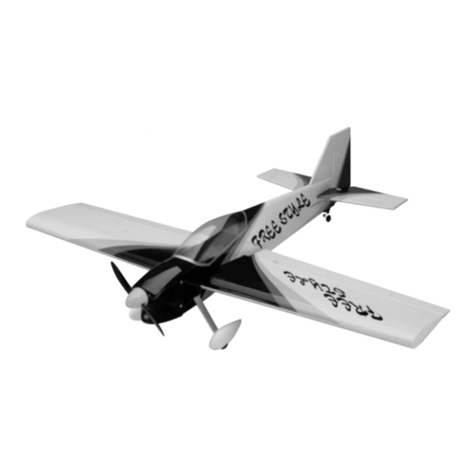
Global Hobby
Global Hobby Freestyle User manual
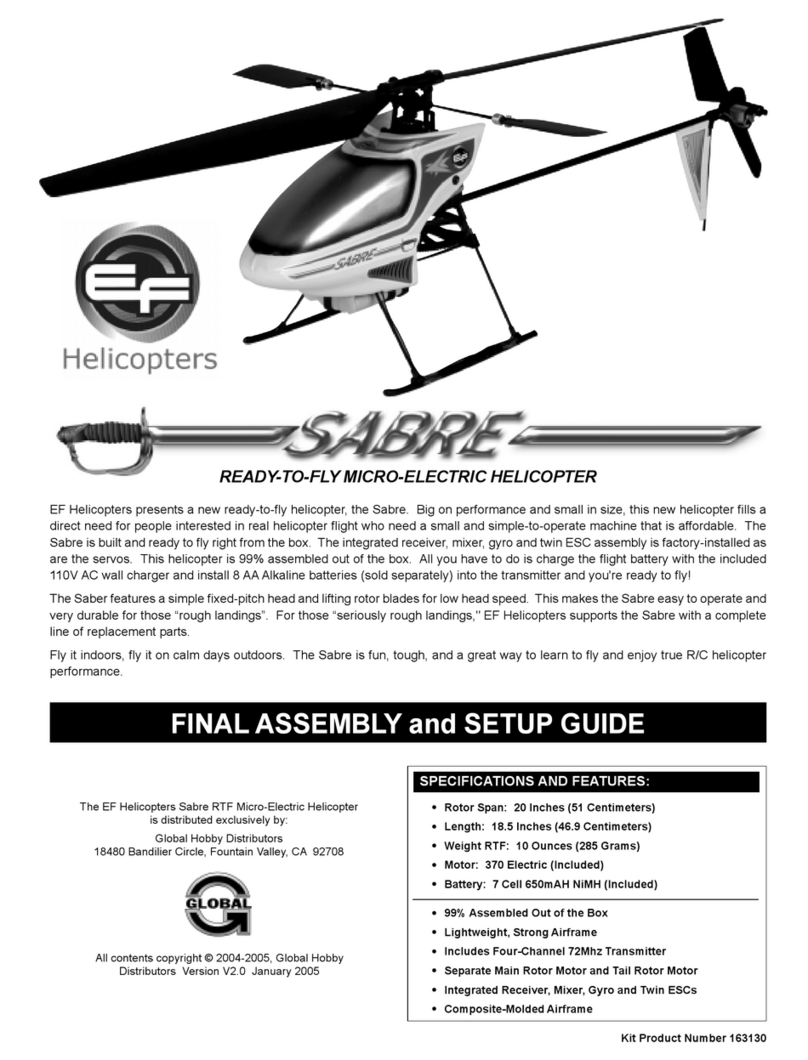
Global Hobby
Global Hobby Sabre User manual

Global Hobby
Global Hobby Wattage Sky Wizard User manual
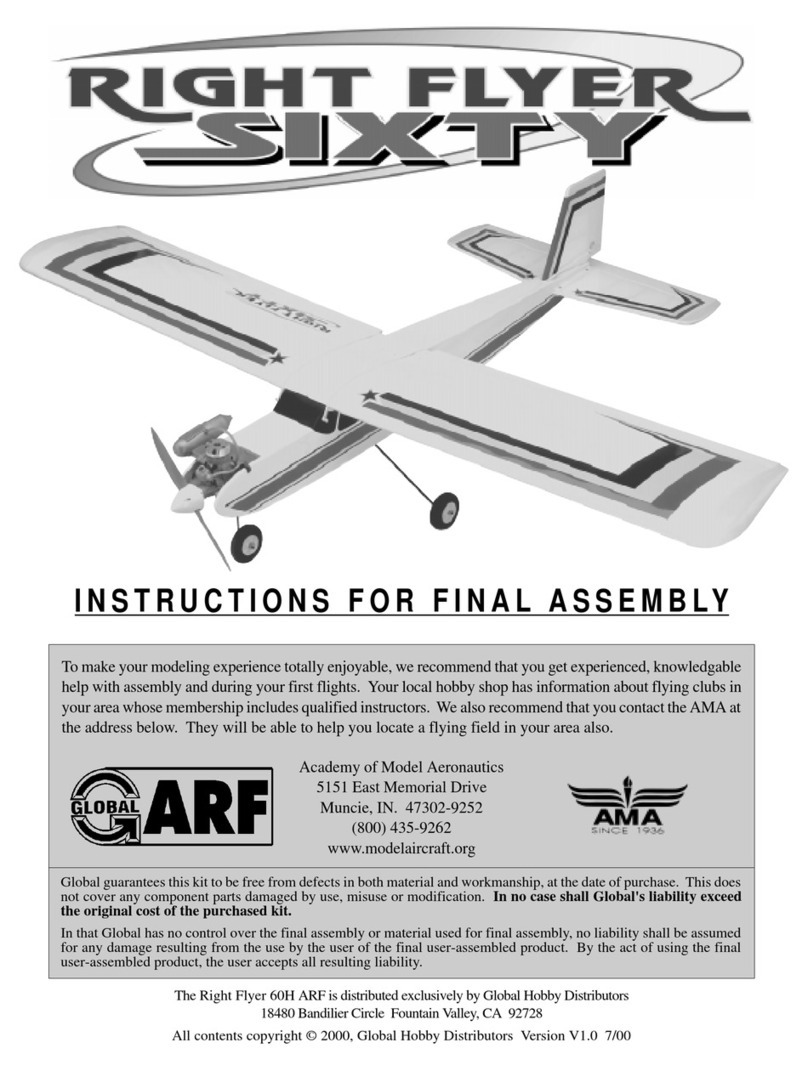
Global Hobby
Global Hobby Right Flyer 60H ARF User manual
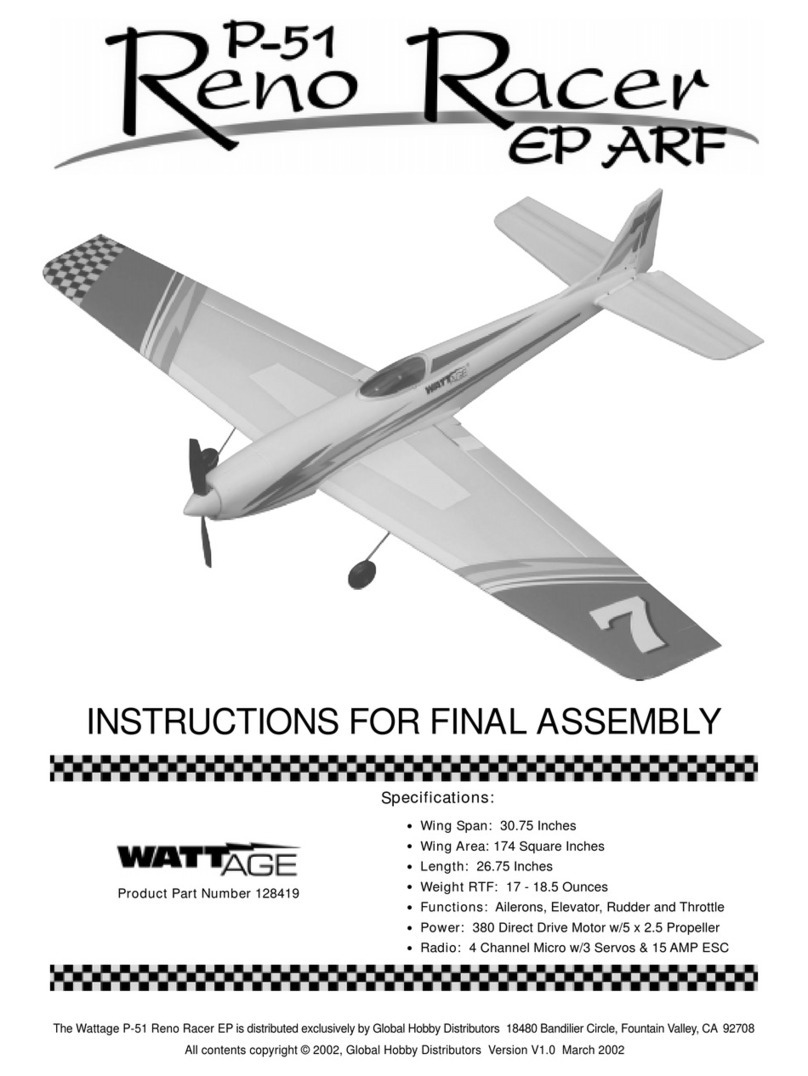
Global Hobby
Global Hobby Wattage P-51 Reno Racer EP User manual
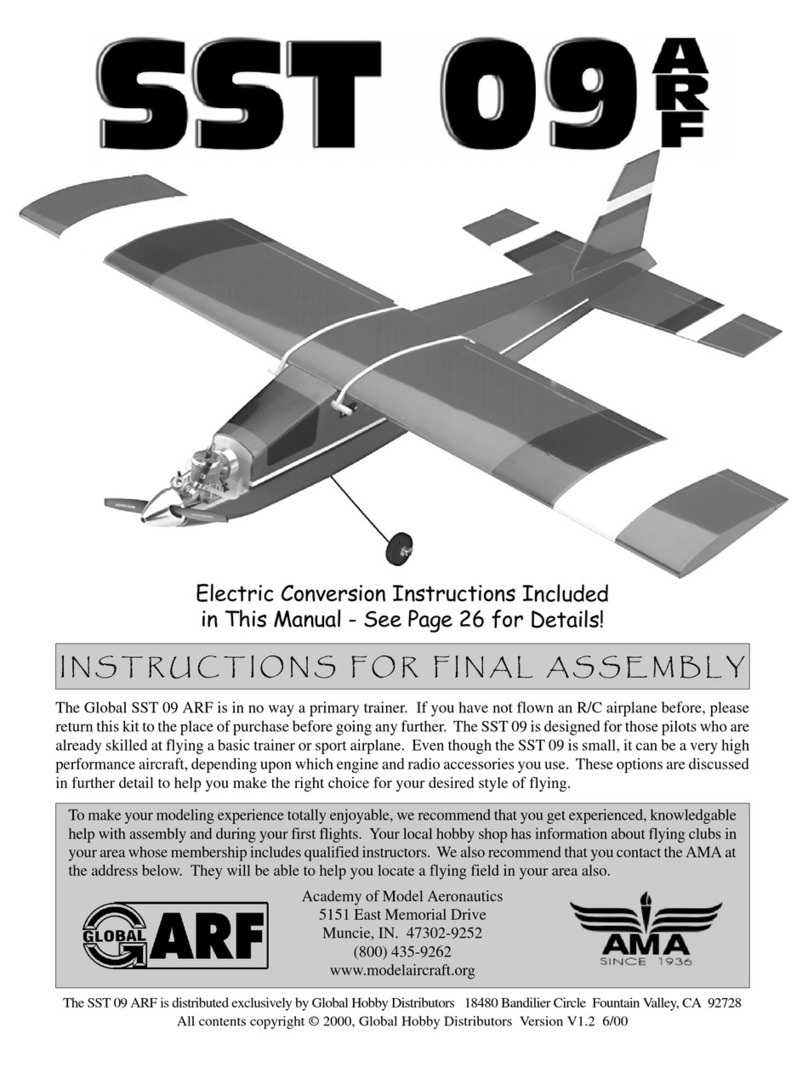
Global Hobby
Global Hobby Global SST 09 ARF User manual
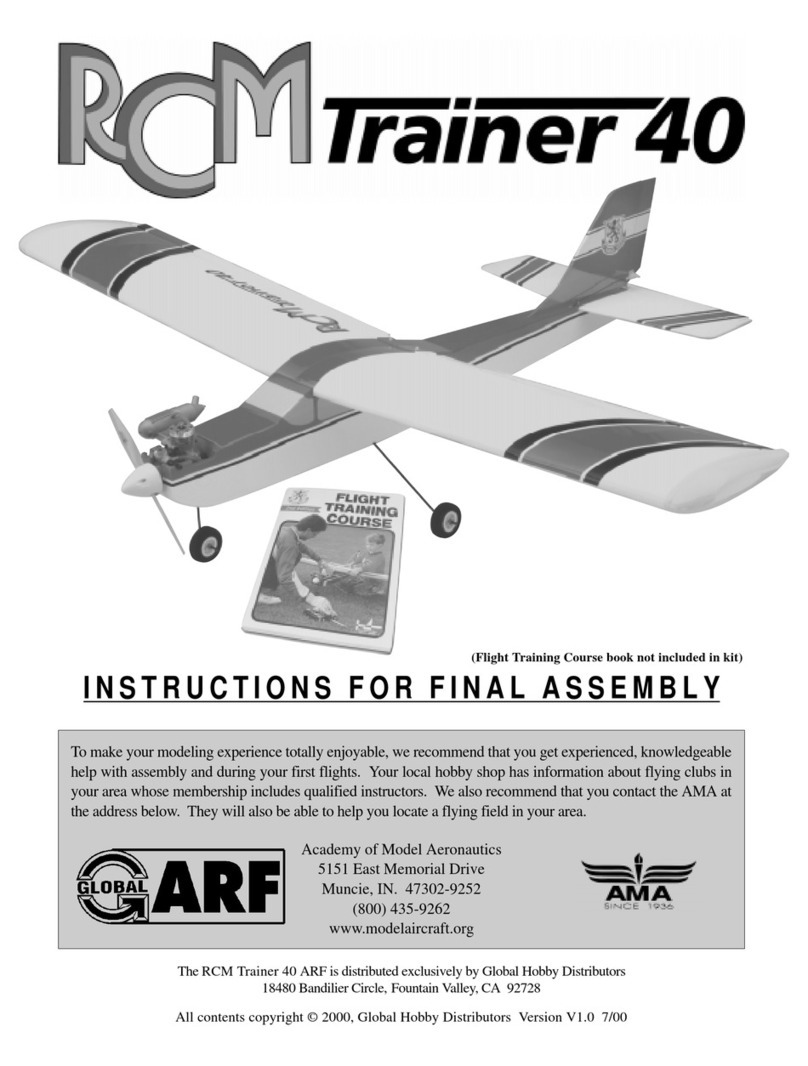
Global Hobby
Global Hobby RCM Trainer 40 User manual
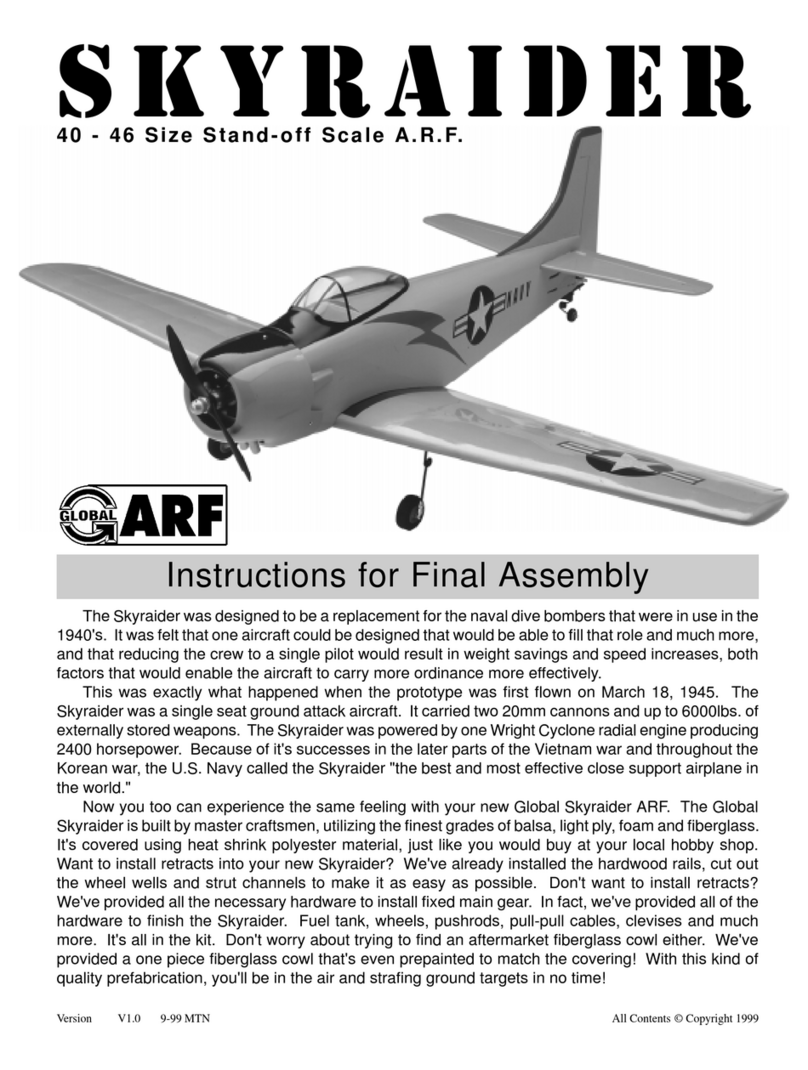
Global Hobby
Global Hobby Skyraider User manual
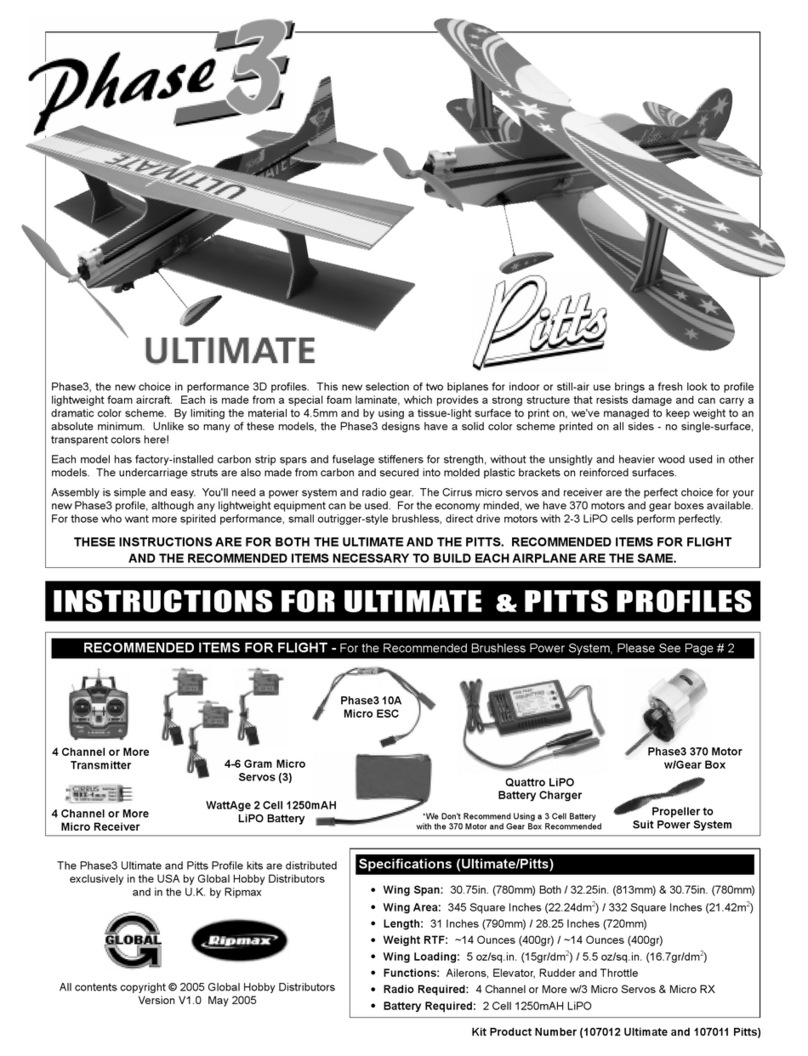
Global Hobby
Global Hobby Phase 3 Ultimate User manual
